Pulse of the People: ‘Women, life, freedom’



ariana goetting, ananya sriram & shareen chahal

Thousands of voices chant, defi ant, bold and united, as they reverberate through the streets of Iran. These are the protests that were hidden under an op pressive regime. These are the cries that were held back by the violence of a gov ernment. Now, these are the voices that have shattered the boundaries of fear and spoken out. “Zan, zendegi, azadi,” or “women, life, freedom,” has become the rallying cry of the protests against the Ira nian government. Anti-government pro tests erupted in Iran and around the world following the death of 22-year-old Mahsa Amini on Sept. 16, an Iranian woman who was taken into custody by the morality police for allegedly defying dress policies. Amini was detained in the city of Tehran for violating the hijab law, according to reports from the morality police. While in custody, Amini supposedly collapsed at the detention facility and was moved to the hospital, where she went into a coma.
Continued on page 6.
Winter sports kick off
katelyn zhao
With fall sports coming to an end and many teams qualifying for the Cen tral Coast Section (CCS) Championships, winter sports held tryouts and their first practices as they prepare for the upcom ing season. Girls varsity golf finished the season undefeated in their league with an overall score of 14-0. They won their sixth consecutive West Bay Athletic League (WBAL) Championship title. With this win, they qualified for the CCS Champion ships, where they came in second place. This win enabled them to compete in the Northern California Championships, placing sixth on Nov. 7.
Continued on page 18.
2022 Midterms: Newsom secures re-election
very close, with neither of the candidates reaching a 50% majority. The candidates will face off in a later runoff race.
Voting for the 2022 midterm elections finished on Midterm Day, Nov. 8. Results for Congressional seats, propositions and local and state official positions have be gun to roll in, with Gavin Newsom secur ing re-election for his second term as Cal ifornia governor.

Democrats currently hold 46 seats in the Senate and Republicans hold 48 seats, with neither party gaining from last election and ultimate control still uncer tain. Tossup races in Arizona, Nevada and Georgia all slightly favor Democrats for now. In particular, the high-profile Penn sylvania race between Democrat John Fetterman and Republican Mehmet Oz was extremely close, with Fetterman lead ing by 3.8 percentage points. The Georgia race between Democrat Raphael Warnock and Republican Herschel Walker was also

Furthermore, Democrats currently hold 184 seats in the House and Republi cans hold 207 seats, with a transfer of six seats to the Republicans from last elec tion. According to the Wall Street Journal, the Republicans have not yet clinched the predicted significant House lead.


Democrat and incumbent Newsom and Republican Brian Dahle were the candidates for this year’s California gu bernatorial race. In the primary election on June 7, Newsom received 61.2% of the ballot votes, and Dahle received 15.1%, according to Ballotpedia. Voters re-elect ed Newsom, who has been governor since 2019, with his support from the blue state remaining strong after he signed Senate Bill 107 to protect transgender youth, as well as 13 reproductive health bills pro tecting women seeking abortion in Sep
tember. Newsom also heavily opposed key Republican figures Ron DeSantis, Florida governor, and Greg Abbott, Texas gover nor, in his campaign. Newsom took 57.5% of votes, according to California’s Secre tary of State page. He kept strong leads in the Bay Area, taking 69% from Santa Clara County, where the Harker upper school is located. Newson had the strongest show ing in San Francisco County, taking 83% of votes, according to AP News.

Upper school civics teacher Carol Green emphasizes the importance of vot ing in midterm elections, especially local races, since they bear the most impact on people’s daily lives.
“Recognize that those local ballots are what hits your pocketbook,” Green said. “People vote based on what they see in their local community. If you don’t like the local policies, you have to go turnout for those small elections.”
Continued on page 3.
Fall Choral Concert premieres two new choral groups

young min
The junior class met with their fourth-grade Eagle Buddies on Davis Field on Friday while the frosh, sophomores and seniors took part in LIFE assemblies covering topics from driving to time man agement. Between periods seven and six, juniors ate lunch and enjoyed their time with their Eagle Buddy families. After get ting to know each other, the juniors led their buddies on a campus tour and en gaged in various activities such as karaoke and board games.

Vocal groups Bel Canto, Camera ta, Cantilena, Dolce Voce and Rhapsody performed in the fall 2022 upper school choral concert, “Music from the Eastern Hemisphere,” on Thursday evening. Two groups, Dolce Voce, a group of sopranos and altos, and Rhapsody, an ensemble of tenors and basses, premiered during this performance. Selections included traditional folk songs, Persian and Israeli arrangements and an Indian raga that in corporates both major and minor modes.
This concert is centered around East ern sounds – the five upper school choirs hoped to create contrast from Western classics the Harker community is familiar with.
“Some of my senior friends will be performing, so since this is our last year, I am trying to go to as many events to sup
port my friends whether that’s in sports or performing arts,” Jessica Tang (12) said. “I am excited to see them perform.”
Concert admission was free and seat reservations were available online via the Harker parent portal prior to the concert.
“I appreciate the ability of music to bring us together as a community, and I am super excited to show what we have prepared because we’ve been working re ally hard for this,” Arjun Gurjar (11) said.
Visit harkeraquila.com for full article.
THE UPPER SCHOOL STUDENT NEWSPAPER OF THE HARKER SCHOOL POST MONDAY, NOVEMBER 14, 2022 VOL. 24 NO. 3 DESIGN BY SARAH MOHAMMED THE HARKER SCHOOL 500 SARATOGA AVE. SAN JOSE, CA
Nonprofit Org. US Postage PAID San Jose, CA Permit No. 2296 STAY UPDATED!
WINGED
95129
Follow us @harkeraquila
SENATE RESHUFFLING Democrats hold 46 seats in the Senate, and Republicans hold 48 seats, with the Democrats gaining one seat in this election as of Nov. 9. sally zhu & isha moorjani
Junior class bonds with their Eagle Buddies
SABRINA ZHU
CHORAL CONCERT Juniors Sonya Apsey, Katelyn Hsu, and Juhi Madala sing in a choral concert rehearsal with upper school music and vocal teacher Susan Nace conducting.
500
AVENUE,
felix chen & shareen chahal
SARATOGA
SAN JOSE, CALIFORNIA 95129
READY TO VOTE Arushi Sharma (11) and Joelle Weng (11) pre-register to vote, handing completed forms to a representa tive from the League of Women Voters.
BALLOT DROP Upper school director of journalism Whitney Huang drops her mid term ballot off into the ballot box.
SABRINA ZHU PROVIDED BY WHITNEY HUANG
isha moorjani, sally zhu & ella yee
Continued from page 1.
In the race for U.S. Senator, incum bent Democrat Alex Padilla defeated Re publican Mark Meuser with 60.9 percent of votes. Padilla became California’s first Latino senator in 2021 and has promoted climate action and economic support for working families since then according to The New York Times.
In addition to local and state rep resentatives, Californians also decid ed on seven propositions. Propositions that earned the majority of votes as of Wednesday evening include Proposi tion 1, which would codify the right to abortion, Proposition 28, which would increase funding for the arts in public schools and Proposition 31, which would continue an existing ban on flavored tobacco products, according to AP News. While California will not certify results until December 16, Prop osition 26, which would allow sports bet ting at tribal casinos and four horse race tracks, Proposition 27, which would legal ize online sports betting, Proposition 29, which would require kidney dialysis clin ics to have at least one physician with over six months of experience and Proposition 30 which would increase taxes on high earners to support climate change pro grams did not seem likely to be approved as of Wednesday.


This year’s election also featured sev eral precedent victories. Democrat Kathy Hochul became New York’s first elected female governor, while Republican and former press secretary for the Trump ad ministration Sarah Huckabee Sanders will serve as the first female governor of Ar kansas. Massachusetts elected Democrat Maura Healey as the state’s first female
governor and the first openly lesbian gov ernor in United States history. In Mary land, Democrat Wes Moore became the state’s first African American governor. Finally, 25-year-old Democrat Maxwell Alejandro Frost’s election to Florida’s 10th Congressional District makes him the first Gen-Z Representative in the House.
ported Alex Padilla for U.S. Senator. Of the seven propositions, over 50 percent of students favored Propositions 1, 28, 29, 30 and 31. Because Harker has connected with the California Secretary of State’s of fice within the last two election cycles, the votes from Harker’s precinct also contrib uted to the overall results of the California Student Mock Election.

“When voting becomes something that we build into our schedules as a re sponsibility of being a community mem ber, we’re more likely to turn out to elec tions,” Green said. “One of our primary goals in AP Government and Civics is to help students practice so that once they are 18, they feel comfortable and confi dent in what they’re doing.”
Prior to Election Day, members of the Harker community identified the economy as a key issue affecting midterm results given the lasting im pacts of the COVID-19 pandemic and the rise of inflation rates more recently.
SENATERACES
SOURCE: THE ASSOCIATEDPRESS



Last month, Harker students participated in a mock election organized by upper school his tory and social science teacher Carol Green to promote the importance of civic engagement. Prior to voting in the mock election, participants browsed pamphlets describing the seven propositions on the California ballot. Once ready to cast their votes, they received their ballots from Civics and AP U.S. Government students manning the registration desk.
Within the Harker mock precinct, 88 percent of voters supported Gavin New som for governor and 87 percent sup
“Voters generally are going to as cribe whatever happens to the economy to the party in power, even though some times it is out of the control of President Biden,” Emmett Chung (12) said.
The overturning of Roe v. Wade in June is another key issue that has been the focus of both Democrats and Republi cans. Upper school history teacher point ed out the situation as an example of the current polarization in the nation.
“For me, the tragedy of this is that it’s another example of where we are in terms of really polarized black-and-white think ing,” Tate said. “People rushed to sort of take to the battlements of this issue, and it really makes me, as a lover of history, weep, because compromise is so rare and such a good thing.”
Visit harkeraquila.com for full article.
DIANE MAIN DIRECTOR OF LEARNING, INNOVATION, AND DESIGN
HURSHMAN
2 WINGED POST NEWS VOLUME 24 • ISSUE 3 NOVEMBER 14, 2022 2022 Midterms: Close races and key issues DESIGN BY ELLA YEE CALIFORNIA GOVERNOR HOUSE RACES As of Wednesday afternoon, Republicans held a lead over Democrats in the House according to The Associated Press. PROPOSITIONS WHY DID YOU VOTE? “A lot of people will think that their votes are meaningless, but if enough people think that, then they are. So, I’m just taking the first step and voting, and hopefully, other kids my age will do the same.” PROPOSITION 1 Guarantee Abortion Rights In State Constitution YES 65% PROPOSITION 26 Sports Betting At Tribal Casinos PROPOSITION 27 Allow Online Sports Betting PROPOSITION 28 Arts and Music Education Funding PROPOSITION 29 Impose New Rules On Dialysis Clinics PROPOSITION 30 Tax Millionaires For Electric Vehicle Programs PROPOSITION 31 Uphold Flavored Tobacco Ban Brian Dahle Gavin Newsom WINNER: Gavin Newsom (D) 58% YLLAS UHZ KJ WILLIAMS UPPER SCHOOL STUDENT “I turned 18 a long time ago, and I vowed that I would vote in every possible election because that’s an amazing privilege, a right we have in [our] country. And a lot of countries don’t have that” DEDIVORP B Y CHRIS DAVIES CHRIS DAVIES UPPER
SCHOOL MATH TEACHER
“It was instilled in me since I was very young that you vote in school board elections, local elections, county, state, federal, everything, because that’s part of our responsibility as Americans”
DEDIVORP B Y CHRISTOPHER
NO 70%
SOURCE: THE ASSOCIATED PRESS SOURCE: THE ASSOCIATED PRESS NO 83% YES 62% NO 70% NO 59% YES 62%
Republican Democrat
ILLIUSTRATION
BY ELLA YEE AND FLOURISH
Speakers, guests at TEDxHarker ‘uncover the unkown’


Students, faculty share talents at second Quadchella of year
 shareen chahal
shareen chahal
Upper school students, faculty and staff enjoyed performances by their peers at the second Quadchella of the school year in the Quad on Wednesday during long lunch. Organized by the Associated Student Body (ASB) Student Events Committee, student performers showcased their various talents through singing, dancing, stand-up comedy and more.
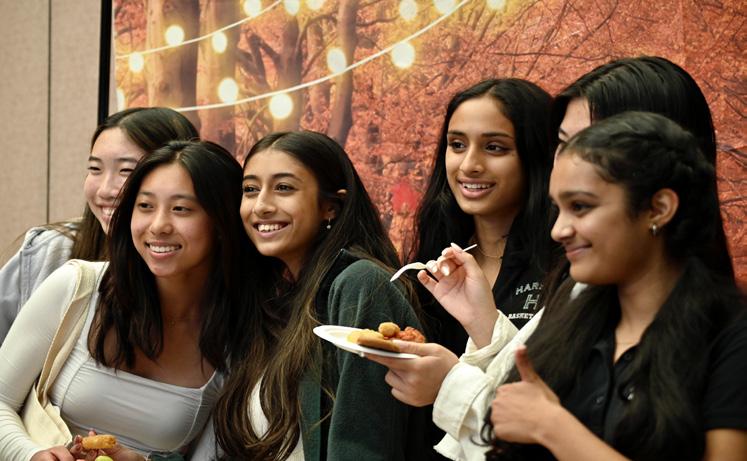
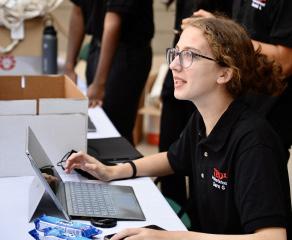
Harker hosted its annual TEDxHark erSchool event, which aims to provide at tendees with entrepreneurial insights, on Oct. 21 in the Nichols Atrium starting at 4 p.m., with over 100 students and teachers attending.
During the first hour of the event, Lego Club, Art Club and Key Club set up booths in hopes to recruit more members. The three clubs showed small examples of how the clubs run, allowing other stu dents to create small samples in order to get a taste of what the club is like.
The other three booths, xTool, Focus Timer and Tufftoy, presented their prod ucts in order to promote them. Tufftoy, which Harker seniors Arin Jain, Rohan Gorti and Zubin Khera created earlier this year, sells dog toys that are more durable than most dog toys that tear after use.
The second half of the event featured industry speaker Guy Kawasaki, former chief evangelist for Apple who current ly works in the same position at Canva, upper school speech and debate teacher

In the first speech, Kawasaki spoke about how to be remarkable through unseen and unexpected practices. He talked about his experiences with Apple co-founder Steve Jobs and how people do not have to solely focus on one topic for all of their life. Instead, it may take more time for people to figure out what they are most interested in.
After Kawasaki’s presentation, Odekirk gave his speech on how people deal with death. Having experienced the death of his wife, Odekirk discussed gain ing a new perspective on the gravity of death.
“I have been concerned with the way that we define life and death since I was a philosophy student in my undergradu ate,” Odekirk said in his speech. “Then af ter my first wife died, and I went through that experience, which was life changing, I had a whole new, much more meaningful perspective on a lot of the things that I had studied before.”
Throughout the speech, Odekirk gave
examples of how people often find it dif ficult to discuss these topics, such as how people were complaining about being online over the COVID pandemic, when millions of people were dying around the world.
In the last speech, Arissa spoke about how mainstream empathy does not help people, but real empathy can actually im pact people. For example, using statistics, she showed how empathy that actually af fects people can have benefits, such as a longer life and better quality of life. During the Black Lives Matter (BLM) movement over the pandemic, many people posted black squares for their profile pictures as a way of saying that they supported BLM but did not actually do anything in reality to support it.
“I’ve really tried to educate myself on social justice movements before speaking out about them or discussing them in a classroom setting,” Arissa said. “Because the worst thing that you can do is say that you are supporting something and then get the situation completely wrong.”
Visit harkeraquila.com for full article.
In conclusion to the fall Quadchella series, this month’s performances fea tured seven acts, opening with Connie Xu’s (9) vocal rendition of What Makes You Beautiful by One Direction. Rei Binkley (10) followed with a self-cho reographed dance to Therefore I Am by Billie Eilish, wowing the audience with a mix of popping, flipping and martial arts-influenced moves. Lucy Feng (12) then followed behind with a perfor mance of Yorushika’s Spring Thief, a Jap anese song, with guitar accompaniment by Nina Franz (12).
“[The audience today] was so nice,” Lucy said. “They were all cheering. We had a lot of time between acts to set up everything, but they kept the energy up and were cheering, chatting. It’s a very relaxed event. Friends get to see me, be cause it happens during the school day, so it’s a very wonderful opportunity.”
Members of the Contemporary Ja pan class Kyle Chang (12), Ashley Ma (12), Jessica Tang (12) and Nina per formed Kakurenbo (Hide and Seek) by Yuuri, an emotional Japanese song about a lonely main character looking for his love. After, Cyrus Ghane (9) played Pre lude No. 1 by Heitor Villa-Lobos on guitar, showcasing complex chords and rhythms.
Harker Signature members Sawyer
“[The audience today] was so nice. They were all cheering. It’s a very relaxed event. [At Quadchella, my] friends get to see me, because it happens during the school day, so it’s a very wonderful opportunity”
LUCY FENG (12) QUADCHELLA PT. 2 PERFORMER OFFICE OF COMMUNICATION
Lai (12), Alan Jiang (12), Anthony Zhao (12), Anaya Mandal (11), Katelyn Hsu (11), Neo Alpha (11), Ashley and Lucy followed with an a cappella cover of What a Wonderful World
Finally, Nupur Gupta (12) and Seli na Chen (11) ended the showcase with an energetic dance performance to Punk Right Now by HYO, stunning the audi ence with their sparkling jackets and an imated moves.
Jesús Corvarrubias, professor of Eth nic Studies and Mexican American Studies at San Jose City College, presented on the Music of Mesoamerica: An Exploration of Indigenous Cultural Expression as part of a collaboration with the Student Diversity Coalition (SDC) in a school-wide assem bly in the Zhang Gymnasium on Nov. 1.
culture in the Americas.
A dedicated instrumentalist, Corvar rubias plays the guitar, keyboard, alto sax ophone and accordion. In 1989, he joined a local Latino band, known as Dr. Loco’s Rockin’ Jalapeño Band. Now, Corvaru bias serves as a member in Los Niteliters, which is another Bay Area band.



Corvarrubias noted the connection between nature and musical expression, prominent in ancient Mesoamerica, and played indigenous instrument that made sound reminiscent of rain.

The LatinX affinity group and SDC collaborated to invite Corvarrubias to speak about Dia de los Muertos and his interest in indigenous instruments and

“As we think about cultural expres sion, every instrument they had was also a way to honor all living things,” Corvar rubias said. “It was about ‘Let’s honor the sounds that we hear in nature because the natural world is a part of who we are.’”
Visit harkeraquila.com for full article.
In preparation for this Quadchel la, student council members worked with upper school Director of Student Organizations Eric Kallbrier and up per school Performing Arts Production Manager Brian Larsen to organize audio logistics and bring student talent and skill into light.
“[Quadchella] is really good com munity bonding,” ASB Student Events Committee member Ella Lan (11) said.
“A lot of the time, high school is pretty stressful for a lot of people, and they are unable to focus beyond their academic life. So, I think it’s a really great way to let more people express what they’ve been working on, and overall I think it’s really fun for the audience to be able to attend and listen to all the different acts.”
Scott Odekirk and student speaker Arissa Huda (12).
WINGED POST 3 NEWS VOLUME 24 • ISSUE 3 NOVEMBER 14 , 2022
TALK THAT TALK Industry speaker Guy Kawasaki presents on “How to Be Remarkable.” Faculty member Scott Odekirk and senior Arissa Huda also spoke at the event.
saahil herrero
by Louis Arm strong.
DESIGN BY EMMA GAO
instrument
indigenous Mesoamericans] had
way to honor all living things.”
school learns about Mesoamerican music at assembly emma milner & felix chen
“Every
[the
was also a
Upper
GREETINGS Marketing associate Sara Glusman (10) checks in guests at the event.
ALENA SULEIMAN
NATURE’S VOICE Jesús Covarrubias holds up and demonstrates playing a jag uar-shaped Mesoamerican instrument. ECIFFO O F COMMUNICATIO N ARISSA HUDA (12) STUDENT “WHY I HATE MAINSTREAM EMPATH” Arissa promotes genuine empathy over performative gestures as the most effective means of doing good ECIFFO FO C O MMUNICATION
STUDENT SUPPORT A group of attendees smile at the photo booth at the TEDx event.
DEBATE
“UNCOVERING OUR RELATIONSHIP WITH DEATH” Mr. Odekirk reveals his personal experience with a loved one’s death and the new perspective he gained.
D
SCOTT
ODEKIRK SPEECH AND
TEACHER
EDIVORP
B Y KRISHMANIAR
shares ways to be remarkable through some unseen practices and urges people to explore their own path
GUY KAWASKI CHIEF EVANGELIST AT CANVA “HOW TO BE REMARKABLE” Kawaski
JASLEEN HANSRA
ALENA SULEIMAN
ALENA SULEIMAN
Visit harkeraquila.com for full article.
Over 300 people killed or injured in Seoul stampede
Secretary of state Anthony Blinken announced in a press release on Oct. 28 an additional $275 million of aid for Ukraine.
This additional military equipment brings the total amount of aid to over $18.3 billion from the beginning of the Biden administration in 2020 and $17.9 billion from the war’s beginning in February. It will be the twenty-fourth set of American aid for Ukraine.
“The United States will continue to stand with more than 50 allies and partners in support of the people of Ukraine as they defend their freedom and independence with extraordinary courage and boundless determination,” Blinken said.

The U.S. has been a reliable partner of Ukraine since the war began, providing it with weapons such as Javelin anti-tank shoulder-held heat-seeking missiles, Stinger anti-aircraft missile systems and High Mobility Artillery Rocket Systems (HIMARS), supplies vital for its continued defence against the Russian invasion.
“I think if the U.S. continues to [provide aid], it could lead to the resolution of the conflict. Seeing how the U.S. is providing aid for Ukraine is definitely giving me hope”
 SONYA APSEY (11) UPPER SCHOOL STUDENT
SONYA APSEY (11) UPPER SCHOOL STUDENT
“I think it’s important that the U.S. continues to aid Ukraine,” Sonya Apsey (11) said, “and I think if the US continues to do this, it could lead to the resolution of the conflict. Seeing how the U.S. is providing aid for Ukraine is definitely giving me hope.”
So far, the Ukrainian conflict has produced 7,821,331 refugees across Europe as of Nov. 8 according to the United Nations High Commissioner for Refugees.
“[I think that the U.S. should be] increasing aid, providing more refugee opportunities, that’s really limited, the amount of actual refugee help the U.S. is doing — it’s a burden mostly put on smaller European nations which we shouldn’t be doing,” Stefan Maxim (10) said. Originally, Russia was predicted to quickly overwhelm the Ukrainian forces, due to their massive advantage in manpower and weaponry. However, that has not been the case.
“To Ukraine’s credit, I didn’t think it was going to last as long as this. I just thought it was going to be a quick surrender by the Ukrainians,” upper school history teacher Jonathan Rim said.

Approximately 156 people were killed and 151 others were injured in a crowd surge in a district called Itaewon in Seoul, the capital of South Korea, on Oct. 29.
The fire department began receiving reports of many people having difficulty breathing at around 10:22 p.m. Witness es reported people falling on top of one another, suffocating and falling uncon scious. After arriving, the fire department transferred bodies to the hospital and ad ministered CPR to those who needed it at around 11:30 p.m. Most of the fatalities were suffered by those in their young 20s.
Itaewon is packed with narrow streets, estimated to be around 45 me ters long and 3.2 meters wide. People be gan crowding into these small alleyways, which led to the crowd surge.
Around 100,000 people crowded in the neighborhood to celebrate Halloween, marking its highest count since the begin ning of the COVID-19 pandemic. Seoul
has been the main venue for the Hallow een party in Itaewon for years. According to upper school history teacher Jonathan Rim, Korea placed strict guidelines on outings during the pandemic.
“Ever since COVID, Korea [has] had very strict restrictions on being able to go out,” Rim said. “So this is the first time they’ve had a Halloween since COVID, and as a result, a lot of people went to Itae won. [Korea] also has a very high tolerance to crowds, so people didn’t think much of it when they first entered the streets.”
Many questions were raised about the lack of police control, to which Min ister Lee Sang-min claimed that protests around Gwanghwamun prevented police from arriving at the scene sooner. Even after police arrived at Itaewon, there was little they could do about the situation.
“I’ve seen a lot of videos of police try ing to get people to coordinate and start moving back,” Young Min (10) said. “But nothing was happening, it was just pure chaos. There was a lack of coordination
and people couldn’t move.”
During a Cabinet council meeting on Nov. 1, President Yoon Suk Yeol ad mitted that South Korea lacks research on crowd management. He urged the use of drones and other high-development tools to create a reliable crowd control system. A meeting with experts will be held by the government to review all national safety regulations.
In the aftermath of the crowd surge, people left flowers and other offerings on an altar outside the Itaewon subway. Most of the survivors have been located, and the period of national mourning ended on Nov. 5 at midnight.
“These [death counts] just feel like statistics to many people,” Jason Shim (10) said. “And I think that feeds into how we can prevent things like this from happen ing again. We have to start acknowledg ing the fact that these [fatalities] are more than numbers. They are people, and it’s personal to everyone.”
Visit harkeraquila.com for full article.
Bolsonaro loses to da Silva in Brazilian presidential election
Brazilian voters elected former leftwing president Luiz Inácio Lula da Silva, popularly known as “Lula,” over incum bent Jair Bolsonaro during a run-off elec tion on Oct. 30 after an Oct. 2 election failed to produce a definite winner.
In the Oct. 2 elections, da Silva re ceived 48.4% of the vote, with Bolsonaro trailing at 43.2%. As this first round pro duced no candidate with over half the votes, the elections proceeded to a second round, where da Silva won by a narrow margin of 50.9% to 49.1% of the vote. Al though this marks the first time an in cumbent lost reelection, this was the nar rowest margin a presidential election has been decided in the country. As a result, da Silva now presides over a deeply divid ed nation.

Da Silva, who was formerly president from 2003 to 2010, oversaw a period of great prosperity in Brazil. The economy was booming at that time, and his welfare programs raised millions out of poverty. Because of this, he became one of Brazil’s most popular presidents in history. How ever, as a result of scandals that occurred during his presidency, he was sentenced to jail in 2017 for money laundering and corruption. The Supreme Court of Brazil later dropped these charges in 2019. Since then, he has bounced back to presidency.
Bolsonaro served as president of Brazil from 2019 to 2022. He has attract ed controversy for downplaying the
COVID-19 pandemic in Brazil and sup porting the deforestation of the Amazon rainforest. Some observers drew similar ities between Bolsonaro and former U.S. President Donald Trump, whom Bolson aro openly admires.
This election saw high levels of po litical violence and misinformation. Am nesty International, a human rights or ganization, reported 42 cases of human
sonaro drastically outperformed poll pre dictions during the first round.
After his loss in the second round, protesters took to the streets, blocking roads in 21 of the country’s 27 states and causing mass disruptions. Some protes tors echoed Bolsonaro’s previous claims that the military was on their side and that they would help him reclaim the election.
Bolsonaro remained silent after his
rights violations in the 90 days preceding the first round and an average of two cases of political violence a day preceding the second round. Both candidates used mis information, with Bolsonaro supporters accusing da Silva of devil worship and da Silva’s supporters accusing Bolsonaro of cannibalism.
Like Trump, Bolsonaro and his sup porters have also cast doubt on his coun try’s electoral system, claiming that his loss would be due to fraudulent voter machines. Brazil’s voting system does not allow early voting and is entirely electron ic. These claims were bolstered when Bol
election loss for two days before giving a speech on Nov. 1. Although he neither conceded nor congratulated da Silva for his victory, he did not challenge the re sults and urged the protestors to remain peaceful and remove blockades. Rightwing government officials authorized the transition of power to da Silva on the same day.
“Peaceful demonstrations will always be welcome,” he said. “But our methods cannot be those of the left, like property invasion, destruction of goods and restric tions on the right to come and go.”
Visit harkeraquila.com for full article.
4 WINGED POST GLOBAL VOLUME 24 • ISSUE 3 NOVEMBER 14, 2022
DESIGN BY ELLA YEE
andrew liang
U.S. to send additional aid to Ukraine
IN MOURNING South Korean officials, including President Yoon Suk Yeol, pay respects to people who died in the Itaewon crowd surge.
PROVIDED
BY MOFA.GO
vika gautham
felix chen
ILLUSTRATION BY SHAREEN CHAHAL
FELIX CHEN
“Peaceful demonstrations will always be welcome. But our methods cannot be those of the left, like property invasion, destruction of goods and restrictions on the right to come and go”
LUIZ INACIO LULA DA SILVA PRESIDENT-ELECT OF BRAZIL PROVIDED BY THE PRESIDENCY. GOV
Fur-ever family Fur-ever family
PROVIDED BY KERRY ENZENSPERGER
Imagine opening your kitchen win dow, letting the crisp morning air diffuse into the room. Suddenly, you hear rus tling below. You gaze down to catch two pigs digging a hole in the dirt. Before you can take a closer look, the ruffling stops. The pigs now lie on their sides back to back as the sun shines upon them. In mere seconds, they have fallen asleep.
Upper school English teacher Bev erly Manning has become accustomed to waking up to such a scene. She smiles as she recalls her pigs, Winston and Archie, names that evince her British heritage, sunbathing together one morning.
“[One] minute, they could be run ning around screaming at each other because it’s food time, but now, they’re buddy buddies, back to back, calm and peaceful,” Manning said.
On another occasion, Manning can be found sitting in front of the TV in the evening, having finished grading paper af ter paper on “The Tempest’’ by William Shake speare. Just as she reaches
for the remote, the “vibrant gold and elec tric blue” plumage of her macaw, Electra, flashes in the corner of her eye. After hav ing been bred in captivity, Electra spends much of her days perched atop Man
“[My animals] are always there, and if they’re not, it’s strange,” Manning said. “They’re my family. They’re used to me being around, and I’m used to them be ing around.”
Shattering the integrity of a centuries-old sport
BEVERLY MANNING UPPER SCHOOL ENGLISH TEACHER
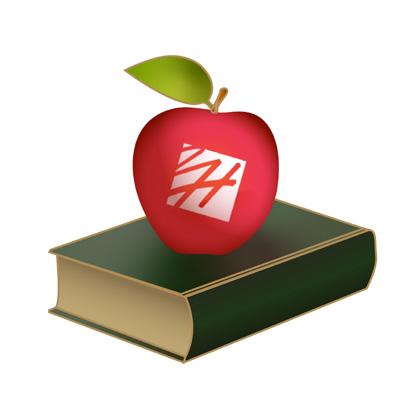
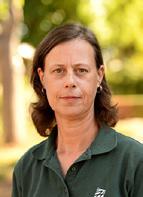

ning’s head. Manning, in return, refers to Electra as a “perpetual two-year-old.”
In addition to Winston, Archie and Electra, Manning’s entourage of animals also includes dogs, goats, parrots and a black cat. One might think managing this menagerie of animals impossible, but they’ve become inte gral in Manning’s life.

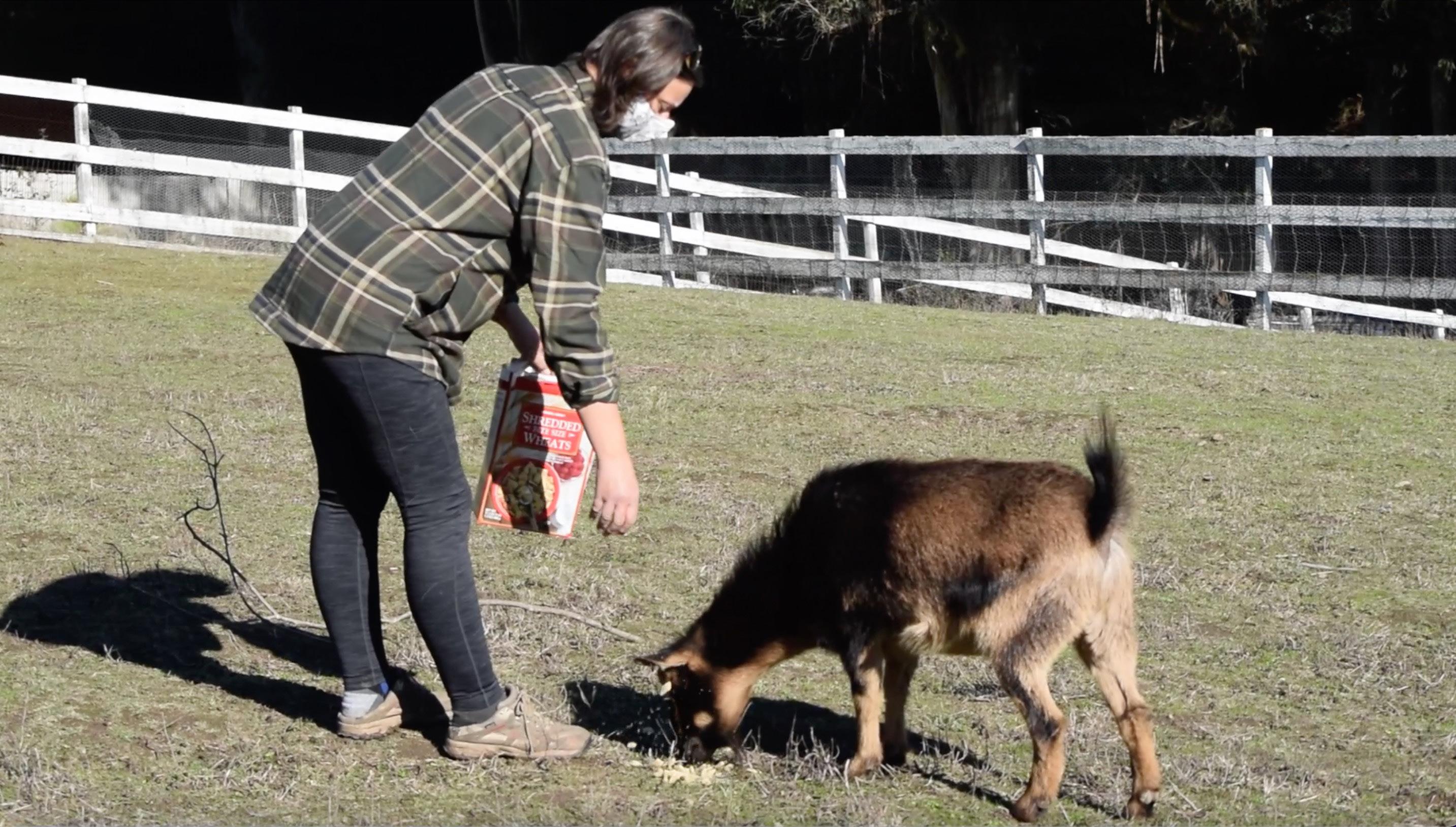

In fact, Manning has always been surrounded by animals. Growing up, she and her family cared for various dogs, birds, rabbits, hamsters and fish. After graduating college, she joined volunteer rescue organizations and worked at ani mal shelters. Through working at one of these shelters, she met and adopted her first dog, Olive. Her pet family kept grow ing ever since.

Just as one would do for one’s family members, Manning always ensures her animals’ comfort and takes special care to accommodate those with health con ditions, such as Electra as well several of her dogs. Despite the difficulties that can accompany such pets, from vet visits to daily maintenance, Manning finds that the joy they bring her far outweighs mi nor inconveniences.

“To me, [my dogs] are not perfect, but perfect,” Manning said. Visit harkeraquila.com for full article.
In a sport where players take their focus and concentration to their limits, where games between professionals often last for hours on end, even a single misstep could make the difference between victory and defeat. So what happens when one of the sport’s most successful and fastest rising players is accused of using chess engines to become an omniscient powerhouse, immune to any misjudgements or errors?
Online chess site Chess.com released a 72-page report on Oct. 4 accusing Chess Grandmaster Hans Niemann of unfair play in over 100 online chess games in his career. The report came after Magnus Carlsen, World Chess Champion title holder since 2013, withdrew from the Sinquefield Cup, a prestigious 10-player tournament held in St. Louis, Missouri with over 350,000 dollars of prize money on the line, and released accusatory public statements on Twitter. In response, Niemann filed a $100 million lawsuit against Carlsen and Chess.com on Oct. 20 for the accusations.
“[Online cheating] is really easy to do, considering that computers are much stronger [chess players] than any humans. But in person, it’s much more complicated, so it’s surprising for something like this to happen”
VYOM VIDYARTHI (10) COMPETITIVE CHESS PLAYER
Niemann experienced a rapid rise to prominence in recent years, performing well in over the board tournaments to achieve grandmaster status and compete in tournaments like the Sinquefield Cup. Although Niemann publicly admitted to cheating in online chess games in the past in a video interview, no definitive evidence shows that he has done so in an over the board game.
With computers now able to beat even the most dedicated of grandmasters, the advent of technology has ushered in a new era of chess, in which online cheating is drastically more prevalent and accessible.
“Online cheating has become a big problem,” Vyom Vidyarthi (10), a competitive chess player with a United States Chess Federation (USCF) rating of 2450 and International Chess Federation (FIDE) rating of 2400, said. “It’s really easy to do, considering that computers are much stronger [chess players] than any humans. But in person, especially in these big tournaments, it’s much more complicated. It usually doesn’t come up, so it’s surprising for something like this to happen.”
BY ANANYA SRIRAM
WINGED POST 5 FEATURES VOLUME 24 • ISSUE 3 NOVEMBER 14, 2022 DESIGN BY DESIREE LUO
Meet Your Teacher: Upper school English teacher Beverly Manning raises menagerie of dogs, goats, birds, pigs and cats
“[My animals] are my family. They’re used to me being around, and I’m used to them being around”
felix chen & edward huang
ILLUSTRATION
ILLUSTRATION BY JESSICA WANG
katerina matta & desiree luo
MOTLEY FLOCK Upper school English teacher Beverly Manning feeds her goat, Orion. “[My animals] give [me] a lot of joy and pleasure, headaches and heartaches,” Manning said. “But I’m glad that I can take care of them.”
OFFICE OF COMMUNICATION OFFICE OF COMMUNICATION
‘Women, Life, Freedom’
Pulse of the People covers timely social justice stories rel evant to our commu nity. In this issue, we explore the causes and impacts of the 2022 Iranian protests.
Continued from page 1.
Amini died on Sept. 16 just three days after her initial arrest. Iranian authorities have since asserted that she died of heart failure after being taken to the hospital, despite her family’s claims that she was in perfectly good health, sparking an uproar of accusations against the Iran’s govern ment for covering up her death. Mahsa Amini is the latest symbol of the oppres sion of Iranian women, and many women are now burning their hijabs and cutting their hair in protest.
“The Iranian protests right now have been going on for about, I would say, al most [six] weeks,” Bahar Sodeifi (10), who attended protests in support of Iran in San Francisco said. “When I spoke about it at [school] meeting, it still wasn’t as large as it is now. People are seeing more of the first steps to revolution right now to over throw the government.”

Protests have gone from denounc ing the strict dress code enforced by the ‘morality police’ to revolting against the Islamic Republic as a whole. Discontent with the nation’s economy and the frame work of society have merged into an im pulse shared by Iranian citizens against authorities.
The Iranian government is respond ing violently to the protests with bullets, tear gas, beatings and arrests, killing an estimated 222 protestors, including more than 30 children. They also blocked Inter net access for Iranians, including commu nication apps such as Whatsapp and mes sages, along with social media, preventing
Iranians from communicating with each other and the rest of the world.
Iranian-American Alan Diba, who avidly attends protests in the Bay Area, also advocates for a regime change and freedom and rights for Iranian people. He noticed how, in all the protests he has at tended, both Iranians and non-Iranians deplore the brutality of the Iranian regime and demand a change in the government.
“We want a regime change,” Diba said. “That is the key for every Iranian that is coming out. They want basically a complete overhaul of a new regime which brings democracy, a new system of gov erning their people. And they don’t want the Islamic Republic of Iran.”
“One of my friends who’s a 10th grader in Iran was texting me that kids would go to school, get their hair headscarf off their head and burn it at school”
are primarily spearheaded by young wom en, a majority averaging 15 to 20 years old, advocating for their rights and freedom to choose how they dress.
Iranian women have protested for rights since 1981, after the creation of the hijab rule, a measure taken by the govern ment after the 1979 revolution. Neverthe less, authorities suppressed the move ments. Women now push for the right to divorce, have child custody and work and travel without permission from a male guardian.


Countries around the world are responding to the Iranian crackdown against the protestors, by issuing sanc tions and restrictions against Iran. The U.S. Treasury’s Office of Foreign Assets Control enforced financial penalties on Iranian leaders. Similarly, the Canadian government designated sanctions against 34 Iranian government entities, while the European Union (EU) currently consid ers sanctions such as travel bans and asset freezing against Iran.
WHY PROTEST?
COMPULSORY HIJAB
Women over the age of nine are required to wear a headscarf to cover their hair and body and will be arrested and punished for breaking this law
1985 PRESS LAW
Prohibits media that with content “harmful to the principles of Islam” and “public interest” will lead to censorship, detention or arrest
The testimony of a male witness is equivalent to the testimony of two females. Women need a husband or male guardian’s permission to work
HISTORY
IRANIAN
Protests have shaken Iran since the 1979 Islamic revolution, a series of events that led the former Pahlavi dynasty to become the new Islamic republic under the pretense of a theocratic-republic. The next violent protests in Iran began in 1999, when students in the Iranian capital Teh ran demonstrated against the termina tion of the reformist newspaper, Salam. Protests hit Iran again in 2009 during the Iranian Green Movement, where Iranian citizens demanded the dismissal of newly elected president Mahmoud Ahmadine jad from office. Despite beginning peace fully, the protests soon turned violent, kill ing approximately 107 known protesters.
While former protests were dominat ed by males, the ongoing Iranian protests
Yet, rather than government sanc tions, the voice of the Iranian protests has sparked solidarity amongst supporters globally. In Berlin, Germany, more than 80,000 protestors marched on the streets, with Iranians traveling from the U.S., Can ada, and more in support. Support for the protests, now lies in the people, to spread the word and empower the citizens of Iran.
“People in Iran have only one request from us outside, that is to be our voice and to retweet, share and talk about it,” Diba said. “The more you support those people, the more it’ll embolden them to protest. But if you get quiet, the Iranian government will come down even harder on these people because they have no out side support. Let the world continuously hear our voice.”
The Iranian people are united. Their protests ring, not only through the nation, but through the world. Let their voices be heard.
Visit harkeraquila.com for full article.
GENDER CODE
ILLUSTRATION BY ANANYA SRIRAM
FREEDOM FIGHTERS Protests broke out in Iran following 22-year-old Mahsa Amini’s death, fighting for a regime change. The protests have been going on for two months.
6 WINGED POST
ariana goetting, ananya sriram & shareen chahal
BAHAR SODEIFI (10) IRANIAN UPPER SCHOOL STUDENT OFFICE OF COMMUNICATION
Iranian protestors took to the streets to fight against the ‘violation of human rights’ by the Iranian government.
OF THE PEOPLE
DAY OF RAGE
CURRENT PROTESTS
OF
PROTESTS 1979 IRANIAN REVOLUTION STUDENT PROTESTS PRESIDENTIAL ELECTION PROTESTS
PROTESTS IRANIAN DEMOCRACY MOVEMENT
DESIGN BY ANANYA SRIRAM 1999 2003 2009 2011 2020 2022 STUDENT
FEATURES VOLUME 24 • ISSUE 3 NOVEMBER 14, 2022
Iranian protests against oppressive regime echo around world
PROTESTS
Subtitles vs. dubbing: Lost in translation?
tling, and how much was lost in translation?
Proponents of subtitles argue that they allow viewers to appreciate actors’ performances in their native tongue. While Jaden Fu (9) first began to watch anime for enjoyment, he now also uses these films to review Japanese vocabulary he learns at school.
He believes that subtitles offer a more genuine expe rience by preserving the full range of ex pression found in a show’s original audio.
“The original au dio of a film conveys the emotion better than dubbing it to a different language,” Jaden said. “Even though you can’t have direct translations between languages, the basic concepts that subtitles convey are usually correct.”





I’ve been us ing subti tles forever, going from watching so many movies with orig inal au dio to You cinema with sub titles, but you can always watch the movie again.”
When Netflix released “Squid Game” last September, viewers immediately raved about the Korean television show’s ingenuity. With subtitles available in 37 languages and dubbed versions in 34, the show united fans from around the globe through its gripping plot. Soon after this initial surge in enthusiasm, however, so cial media began to erupt with claims that viewers who used subtitles “didn’t really watch the same show.” This begs the question: How much of the original content passed through the sieve of subti
Another common complaint about dubbing is the mismatch between au ditory and visual content. Dubbed lines of a film or show fail to correspond to the lip movements of characters, which some find distracting or unpleasant. Akul Goyal (10), an avid watcher of Bollywood movies, uses subtitles to fill in the gaps between his knowledge of Hindi. Though he acknowledges that subtitles can be challenging to follow, he considers them a better option than dubbing.
“It does take some practice to get used to subtitles,” Akul said. “But since
Dubbing a show with English audio can also help viewers study a foreign lan guage. Along with switching the language settings on her devices, Kaitlyn Wang (11) watched “Jane the Virgin” with Spanish dubbing to prepare for the listening and oral sections of the AP Spanish exam.


“I’ve watched ‘Jane the Virgin’ so many times that I already knew what the characters were going to say,” Kaitlyn said. “I wanted to watch the show in my free time anyway, but this way I could study Spanish at the same time. I used to have a hard time understanding Cuban, Colom bian and Puerto Rican accents, but watch ing the show was good practice.”
While preference for subtitles or dubbing may differ depending on the sit
Micro-trends pervade social media
Social media’s grasp on fast fashion has detrimental consequences
options. Upper school French teach er Galina Tchourilova uses movies as a “springboard” for teaching her level four students about French culture, history and traditions. Tchourilova frequently ob serves mistakes in translations but sees them as “good teaching moments.”
“I’ll take a French sentence, compare it to the English subtitle and ask students if it’s the same, if it’s precise, if it’s accurate,” Tchourilova said. “Very often we’ll notice differences, but some of them are under standable because the movie can have puns or cultural references, which are of ten impossible to translate accurately.”
Understanding a foreign movie, or another culture for that matter, may re quire more knowledge than subtitles or dubbing can offer.
Visit harkeraquila.com for full article.
young min
Chunky jewelry. Hawaiian print dresses. Patchwork jeans. Cow print. These trends once reigned over fash ion social media. Now, they gather in the aisles of Goodwill, collect dust in the depths of closets and accumulate in land fills. These are the unfortunate effects of micro-trends: Just as quickly as the clothes sell out, they are forgotten.
One scroll through TikTok or Ins tagram reveals how these micro-trends plague the fashion industry. Clothing un boxings, DIYs and outfit posts flaunt the season’s new “must-have” items and send thousands of social media users flocking to ‘add to cart.’ Companies like Shein, H&M and Zara rush to meet these demands by quickly and inexpensively mass-produc ing these clothing items. Green Team offi cer Joelle Weng (11) recognizes the impact of this rising influencer culture.
“Influencers are traditionally used to promote products,” Joelle said. “Their ad vertising is more subtle than targeted ads,
so people buy things that they promote and are influenced without realizing it.”
Unlike traditional fashion trends that last five to ten years, most micro-trends last for just one season, accelerating trend
Micro-trends also deprive people’s fashion senses of originality. Despite us ing social media for inspiration, fashion enthusiast Shreya Balakrishnan (12) stays true to their own preferences when mak ing fashion choices and emphasizes the importance of developing one’s own style.
“[Micro-trends] kill the ideas of indi viduality and fashion because people just follow these trends,” Shreya said. “They don’t build up on their own style or what they are comfortable and confident with.”
cycles and quickly deeming particular styles as outdated. Shiv Deokar (10), who follows fashion trends, notices TikTok’s role in shortening trends.

“Social media has mangled the trend cycle where nothing’s in for a really long time,” Shiv said. “I see a new thing on Tik Tok every other day. All the content on there is so immediate and nothing really stays in your head for very long.”
Micro-trends also have detrimen tal effects on the environment with 85% of clothes in the U.S. ending up in land fills. Here, the polyester often used in fast fashion break downs into microplastics. Shreya draws a connection between plas tic pollution and shortened trend cycles.
“If you’re changing your entire clos et or your entire lifestyle based on trends, you start a process where you’re just wast ing clothes from previous trends,” Shreya said. “It builds up because eventually you’ll see those in thrift stores, and those eventually end up in landfills.”
Visit harkeraquila.com for full article.
JULIE
(11) STUDENT
 JESSICA WANG (10) STUDENT
JESSICA WANG (10) STUDENT
WINGED POST 7 A&E / LIFESTYLE VOLUME 24 • ISSUE 3 NOVEMBER 14, 2022
goetting, selina xu & claire zhao
ariana
DESIGN BY ARIANA GOETTING
ella yee
Most fans of foreign shows take a strong stance, but both options have their flaws
Upper school students often find drawing a creative outlet that allows them to explore various emotions. Through art, they hope to express themselves and enhance their observa tions of the world around them.
ILLUSTRATION BY ALENA SULEIMAN
ILLUSTRATION BY ARIANA GOETTING
ILLUSTRATION
BY ALENA SULEIMAN
“Social media has mangled the trend cycle so that nothing’s in for a really long time”
SHIV DEOKAR (10) STUDENT
PROVIDED
BY SHIV DEOKAR
“It allows me to create anything I want to. It’s also cool picturing something in your head and replicating it on paper.”
P R O VIDEDBYRUMI GUPTA
RUMI
GUPTA (10) STUDENT
“Art has the unique ability to make people feel things. Although there are different types of art, something about that visual aspect produces an emotional response in me and in lots of other people too.”
P
R OVIDEDBY
JULIE SHI
SHI
JESSICA TANG
“The process of creating something with my own hands is a special mindset. When I’m drawing, hours can go by in minutes because I am so invested in the product.”
Sports photographer ?
Ben Green captures intimate and decisive moments of athletes
Stripe Club stripes up a masterpiece each week

alison yang
It began with a yolk-yellow wall.
brandon zau & alena suleiman
Sports: one of the most ubiquitous and well-known forms of entertainment filled with action, tension and drama. But behind-the-scenes of each game and event is a dedicated group of people pursuing to capture the emotion-packed moments of the sport. From local peewee scrimmages to the largest stadiums broadcasted to millions of viewers around the world, sports photographers like Ben Green aim to preserve the decisive mo ments of games through their pictures.
After picking up a camera in his ju nior year of high school, Bay Area native Ben Green fell in love with photography because it felt natural and fun. While in college, Green got a job at the University of Oregon’s student newspaper during his sophomore year after noting a lack of staff photographers.
BEN GREEN PROFESSIONAL SPORTS PHOTOGRAPHER PROVIDED BY BEN GREEN

Green is now based in Buffalo, New York working as the team photographer
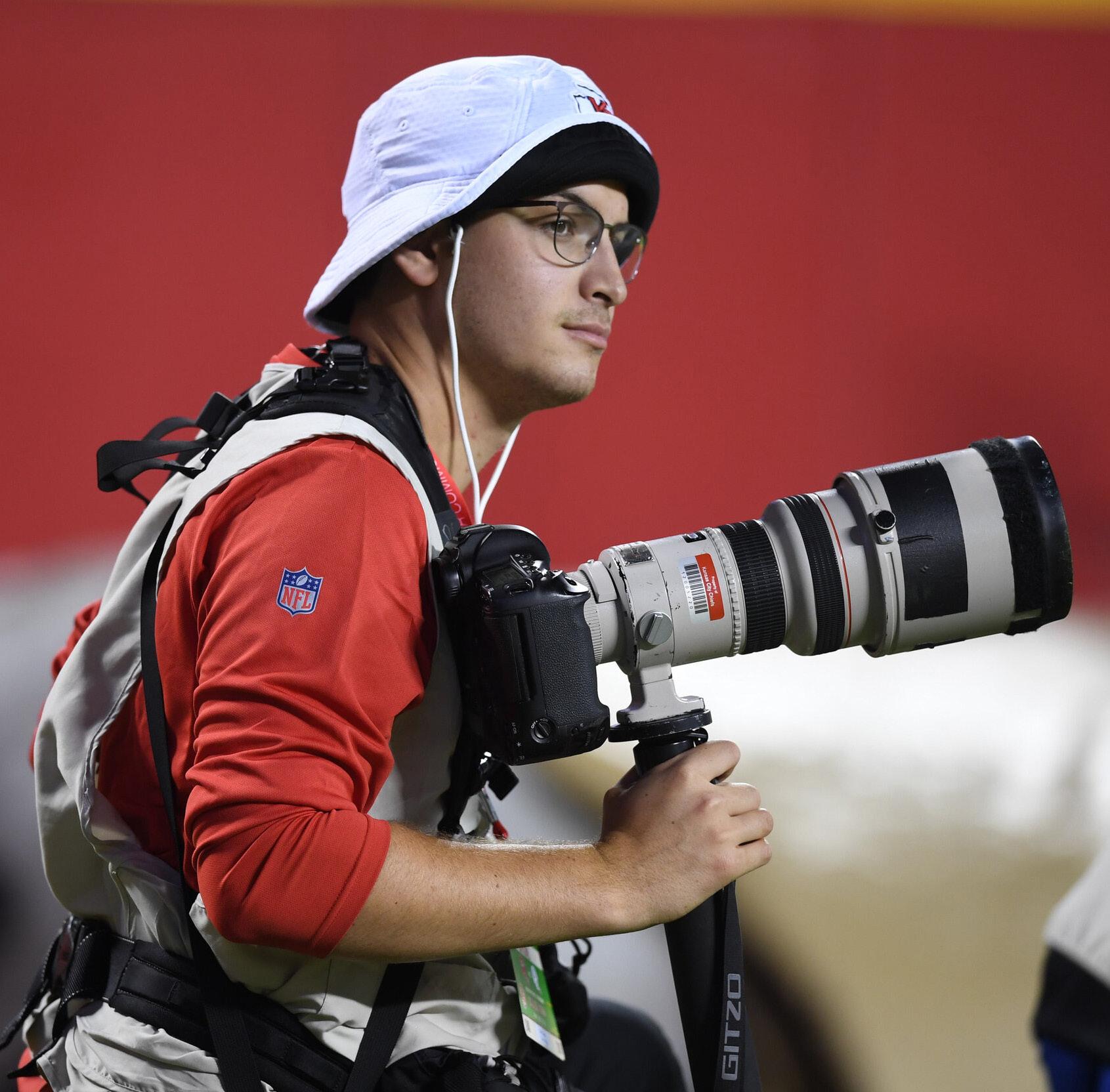
for the NFL team Buffalo Bills, NHL team Sabres and NLL team Bandits, and has also covered major sports events includ ing the Tokyo 2020 Olympics, 2022 Pro Bowl and more. Green takes a special focus on sports photography, hoping to capture professional athletes heroically by incorporating low angles while shooting.
“One of the things that I really love is making people look great,” Green said. “Not as in, ‘Oh, you’ve got a great smile,’ but more as in the hero aspect of it. Es pecially when we’re talking about profes sional athletes, [I try to] portray them as
what they’re built up to be, but at the same time show that they’re human.”
Throughout his career, Green noted the importance reaching out to mentors. Support from other fellow photographers helped Green improve his portfolio and build meaningful connections.

“The biggest piece of advice that I have is you need to build your network,” Green said. “The amount of mentors I have never stops growing. If it weren’t for those people, I wouldn’t be where I am today.”
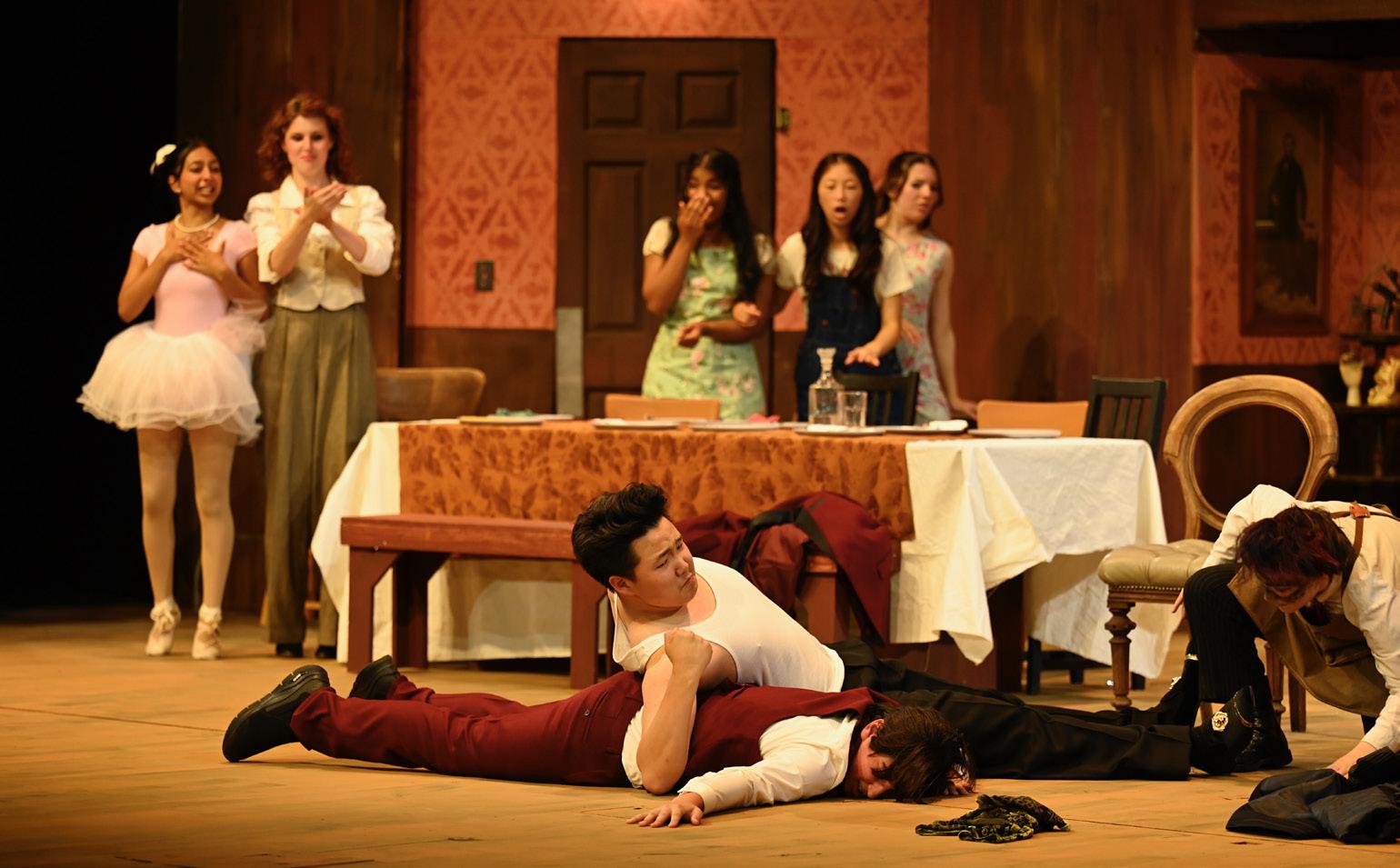
Visit harkeraquila.com for full article.
Sycamores galore: Fall Play enraptures audiences
do not last long, scenes and lines weaving out of one another in an intimate dance of success and failure in the life of two fami lies, each in pursuit of their own ideals of the American Dream.
Putting such a complex and fast-mov ing play required the combined efforts of both a hardworking cast and talented crew. 18 members of the evening cast, 19 of the swing cast, and 9 crew members worked tirelessly from the start of August to the end of October. Tech Theatre mem ber Karina Chen (12) remarks on her ex periences working as deck crew.

Nearly four weeks later, the Dickinson Visual Arts Endowment Artist in Residence, Leah Rosenberg, perches on a ladder in the Rothschild Performing Arts Center (RPAC), rolling on a final layer of “Strawberry Red” paint on the hallway’s wall. Rosenberg, who began her residency on Oct. 17, has been working in tandem with Art Club and the Vi sual Arts department to develop Stripe Club.



Stripe Club is the community offshoot of Rosenberg’s project, “If Time Were a Col or,” the large mural in the RPAC. Its layers of paint correspond to overlooked everyday objects.
At the beginning of her residency, Rosenberg and the colors’ presence in the RPAC were an unfamiliar sight, but now, students pack the painted hallway. Stripe Club can also be seen outside the RPAC lob by, offering screenprinting of the day’s color each Monday and Thursday after school. Any student can join in, designing their own patterns on a canvas or bandanna.
As the weeks have passed, more and more students have picked up bandanas and begun printing their designs.
Visit harkeraquila.com for full article.
young min, jessica wang & alison yang
The lights dim, the 1930’s swing mu sic deepens – a flash of blue reveals a liv ing room flooded by warm yellow lights.
At the center of it all sits Penny Sycamore, curls neatly set, working at the typewriter.
Two casts performed the three-act comedy “You Can’t Take It With You” for the annual Fall Play in the Patil Theater. The evening cast performed at 7 p.m. from Thursday to Saturday, and the swing cast performed at 4:15 p.m. on Wednesday and 2 p.m. on Saturday, each show run ning for 2 hours and 15 minutes with one intermission.
At first glance, the play seems to be
like any other high-tempo comedy; as the audience’s eyes adjust to the light and focus on the stage, it becomes apparent that it is anything but normal. Spaces for eating blends to writing to dancing and everything else in between in an “everyman-for-himself” set.
The rattling rhythm of a typewriter draws the audience’s attention center wards and up, straight to Mrs. Sycamore, perched in a nook of the stairs in all of her effortlessly eccentric glory.
Barely a breath goes by before Mrs. Sycamore’s clacking is interrupted by Es sie, her eldest daughter, dancing and fly ing about the room. One after another, the rest of the family tumbles in. In the Syc amore house, quiet lonesome moments
“The thing about tech theater is that you can see the big picture but also what goes on behind the scenes,” said Karina. “Although I am not an actor myself, I feel like I still had my own role to focus on, not on the stage but working behind it. I can see the actors and how they act, but I can also see the timing of how everything is put together, whether it be the timing of the cues or how scenes connect with each other, and that’s rewarding too.”
Picking an ensemble to depict the intricate family relationships was a very grueling process as well. Auditions began in August, led by upper school theater teacher and director Jeffery Draper as well as Tony and Tanna Kienitz. Actors brought monologues from any piece of work, and the whole process was filmed. Callbacks soon followed, where actors were test ed for various characters as well as cast chemistry. Cast lists were released at the end of August, and the race to put the play together ensued.
Visit harkeraquila.com for full article.
PROVIDED BY BEN GREEN
“When we’re talking about professional athletes, [I try to] portray them as what they’re built up to be, but at the same time show that they’re human”
DESIGN BY ALENA SULEIMAN
This recurring profile series features stories and experiences of individuals with unique professions
8 WINGED POST A&E / LIFESTYLE VOLUME 24 • ISSUE 3 NOVEMBER 14, 2022
A SHARP EYE Camera in hand, photographer Ben Green prepares to shoot a National Football League (NFL) game. Green works as the team photographer for the Buffalo Bills.
ZHAO
WRESTLING CHAMPIONSHIP Jason Shim (10) pins Henry Fradin (9) to the ground with his arm in a wrestling match. Jason played Kholenkov, and Henry played Mr. Kirby.
KATELYN
STRAWBERRY RED Artist Leah Rosenberg paints the Rothschild Performing Arts cen ter (RPAC) with a new color each week.
BUMBLE BEE YELLOW The eighth color of artist Leah Rosenberg’s project titled “If Time Were a Color” is Bumble Bee Yellow.
“Every artist brings a different practice, a different set of ideas and way of working. That’s the most exciting thing”
ECIFFO
O F COMMUN ICATION
PILAR AGUERO-ESPARZA VISUAL ARTS TEACHER
“The more colors that were on there, the better [and] more whole it looked. I’m excited to see [what’s coming]”
LA S O N YANG
EMILY BRYAN (9) STRIPE CLUB MEMBER
“I feel like I’m part of the artwork that’s being painted. Each day is something different and new”
LA I S O N YANG
ALENA SULEIMAN
KATE
RUSSELL (11) AP3D STUDENT AND STRIPE CLUB MEMBER
ALENA SULEIMAN
Why we need LGBTQ+ history month now more than ever
katerina matta
As the political sphere becomes in creasingly polarized, our classrooms have turned into battlegrounds. Debates abound over whether Critical Race The ory can be used in curriculums, or over attempts to remove books for overly “sen sitive” material, where sensitive often denotes stories that stray from the het eronormative, white narrative. This new wave culminated in March with the pass ing of the “Parental Rights in Education Act” in Florida, referred to by opposers as the “Don’t Say Gay” bill, which aims to limit formal sexual and gender identity education at a level that is “age appropri ate or developmentally appropriate.”
In the wake of these developments, this October’s LGBTQ+ History Month provides the urgent opportunity to uplift and affirm queer voices. Founded in 1994 by Rodney Wilson, a gay Missouri high school teacher, the month commemo rates the ongoing fight for LGBTQ+ rights and acknowledges the historical figures and events which have propelled the movement to where it is today.
By engaging with LGBTQ+ history, we not only recognize but also validate the presence of the queer community throughout our history. When critical events like the 1969 Stonewall riots, which jumpstarted the LGBTQ+ rights move ment, are put on the same plane as Wash


year,” making them one of the most atrisk populations in America, and actively combatting the feelings of shame and in validity they face at the high-school level is a critical step towards their protection.
ington crossing the Delaware, it helps queer communities feel visible and brings queer students comfort in knowing their identities exist and are something to be celebrated. According to The Trevor Proj ect, 45% of queer youth “seriously consid ered or attempted suicide over the past
Studying LGBTQ+ communities throughout history fosters a deeper un derstanding of the systemic issues and prejudice they still face today. Only through being cognizant of structural in equities, such as reduced access to health care, can we combat them. Increased edu cation will allow us to gain this awareness. Embracing LGBTQ+ history can also bring into the spotlight how different aspects of identity like race intersect with and com pound the difficulties of being LGBTQ+ in America. There is a large disparity in the rates of suicide among queer children of color compared to their white counter parts, likely the compound result of mul tiple forms of prejudice.
Visit harkeraquila.com for full article.
Jetéing over gender stereotypes as a male ballet dancer
As 10-year-old me walked into a bal let studio with my head down, I tried to avoid the gaze of other ballerinas. But I knew I was going to be noticed; as a boy, my short hair, white shirt and black tights starkly contrasted with the colorful leo tards of other girls.

From the moment I entered the class room, joyful conversations were hushed into whispers, and I didn’t need to look up in order to feel the gazes boring into my head. Once I took my place at the barre, I finally looked up, and in the mirror saw myself, a thin, frail boy not knowing what to expect of the social norms in this ballet academy.
I thought to myself, maybe this would be a one-time experience; as I go to more classes throughout the year, perhaps I’ll get to know my peers better and form good relationships.
I misunderstood the rigidness of ste reotypes and social norms that I’d soon face.
I would make mistakes in class. A lot of them. Compared to female dancers, I started my journey late. I began training when I was 9 years old, but girls usually begin during kindergarten or elementa ry school. I was behind, and I recognized that immediately.
What I also recognized was my class mates’ reactions to my failures, and how those reactions compared to the reactions
SOURCE: THE TREVOR PROJECT
to other dancers’ errors. Whenever I stum bled after a pirouette or fell to the floor from a jump, I would never receive the same encouraging words as when others make the same mistake. I became more afraid, more timid, more reluctant to seek help and improve.
For a long time, I would repeat the same pattern every class. Whenever I line up in the corner waiting for my turn to be gin a ballet combination, I can feel the ap prehension and the fear of messing up in the middle of the studio. The music would begin, I would make a grand entrance and flow with the music, moving with ease, until I step on the wrong foot. I misapply my force, my movements feel unnatural and I fall behind on the music. Everything escalates, and I can feel the blood rising in my face when I finally regain control of myself and end satisfactorily. But instead of being able to find solace with other dancers, I find myself trying to keep my embarrassment inside.
But even when I did make progress on a skill, I wouldn’t hear claps and cheers; I would just gain the privilege of not being the target of judgmental whispers. Why should it be harder for boys to find a place in a ballet class? Why should stereotypes of what boys are expected to do get in the way of their success?
Stereotypes have often instigated conflicts and are one of the most innate parts of human nature.
Visit harkeraquila.com for full article.
OPINION 9 WINGED POST VOLUME 24 • ISSUE 3 NOVEMBER 14, 2022
DESIGN BY ARJUN BARRETT
By engaging with LGBTQ+ history, we both recognize and validate the
of the queer
throughout
anwen hao ILLUSTRATION BY ANGELINA HU
Facts
presence
community
our history
Fast
55% 62% LGBTQ+ teens consider school an LGBTQ+ affirming space LGBTQ+ teens feel partially or fully accepted by community 89% LGBTQ+ teens enjoy LGBTQ+ representation in media
ILLUSTRATION BY ARIANA GOETTING
BY LAKSHMI MULGUND AND SABRINA ZHU
BUILDING
sabrina zhu
From holding a door to giving a family member a call, there’s an endless number of ways that you can be kind to the people you love. And with Interna tional World Kindness Day taking place on Nov. 13, it’s the perfect time to ex plore what kindness means to us and our community.

World Kindness Day, started in 1998 by the World Kindness Movement, is cel ebrated in over 28 countries around the globe, including the United States, Japan and Canada. The day was founded on the belief that kindness brings people to gether and helps them to work through conflicts and challenges. And at the up per school, there are various initiatives and groups that dedicate themselves to this belief.
For example, the LIFE Board, ad vised at the upper school by Kelly Horan, organizes events that are designed to help students as they navigate through out high school and beyond. Horan be lieves that part of understanding kind ness is learning to be kind to yourself, which she realizes that many students might struggle with.
In particular, Horan urges students to avoid living with too goal-oriented mindsets and instead to find happiness in hobbies that are not based around ac complishments.

“Being kind to myself is understand ing that I cannot be everything to every one in a perfect way all the time,” Horan said. “That’s the hardest piece of it be
BUILDING KINDNESS

KINDNESS
Celebrating World Kindness
what does kindness mean to you?
so much bandwidth.”
Beyond the LIFE Board, there are other initiatives on campus designed to foster kindness, compassion and growth, including the United Nations Interna tional Children’s Emergency Fund (UNI CEF) Club. As a branch of the larger UNI CEF organization, this club is dedicated to community service and fundraising. For example, one main activity the UNI CEF Club leads is birthday card deco rating, where officers and members get together to write encouraging birthday cards to children from disadvantaged families.
“Our main goal with the birthday card decorating is to foster some sort of
Lavanya explains that Harker stu dents come from unique places of privi lege and should use their privilege to spread kindness to other people.


“Just at its root, the UNICEF orga nization is about service and bringing resources to people who might not have them,” Lavanya said. “Within Harker, what we’re really trying to do is to spread the message of empathy and kindness outside of our community. At Harker, we have a lot of privilege, and we want to take that privilege and use it to spread kindness.”
Despite the number of organizations like the LIFE Board and UNICEF Club at Harker, it is ultimately up to each of us to actually act with kindness in all aspects of our lives. These acts of kindness can be big or small, and upper school learn ing specialist Kadar Arbuckle notes that one of the easiest ways to help foster a caring community is to just reach out and talk to another student.

Arbuckle, working with upper school counselor Rosalyn Schreiman, started the “Community Conversations,” project a few years ago, and he’s noticed the impact these simple conversations can have.
“[I hope that our students can] be kind to themselves. I hope that our students have an acceptance of who they are, what strengths they bring to the table and what gifts they have to give to the world. And [I hope they know] that they can lean on other people, in order to be able to continue to make the community a better place”
KELLY HORAN UPPER SCHOOL LIFE BOARD ADVISER LO V A XU
“The UNICEF organization is about service and bringing resources to people who might not have them. Within Harker, what we’re really trying to do is to spread the message of empathy and kindness outside of our community. At Harker, we have a lot of privilege, and we want to take that privilege and use it to spread kindness”
LAVANYA SUBRAMANIAN
BYLAVANYA SUBRAMANIAN
KADAR
connection between us and these kids
“I make an effort to just have those random, small talk conversations,” Ar buckle said. “I’ve had so many interac tions go well, because I’ve just been will ing, and that other student was willing, to engage in a quick conversation. At our Community Conversations, I’ve heard students say something encouraging to another student. And that is everything,
Visit harkeraquila.com for full article.
(12)
UNICEF CLUB OFFICER
“[Kindness is] going out of your way to be more than just a decent person. A decent person would maybe pick up trash, but a more than decent person would go out of their way to maybe get someone an extra drink”
ALBERT YAO (9) STUDENT ACTIVITIES BOARD REPRESENTATIVE

10 WINGED POST DOUBLETRUCK VOLUME 24 • ISSUE 3 NOVEMBER 14, 2022
“Every single student here works so incredibly hard to reach their goals. And, to me, that’s enough. I hope students can understand that everything [they’re] doing is okay. Any bump in the road is expected”
ARBUCKLE UPPER SCHOOL LEARNING SPECIALIST SABRINA ZHU
Learning to practice compassion with others as well as yourself
ILLUSTRATION
ILLUSTRATION BY
RB A N DONZAU ORP V D E D
LAKSHMI MULGUND
KINDNESS AND GRATITUDE
AND GRATITUDE KINDNESS
Kindness Day in the community
RANDOM ACTS OF KINDNESS:
Give someone you know a hug, a highfive or even just a smile
Cheer on our winter sports athletes and attend a few games
Take care of yourself, and remember to give yourself breaks
Be kind to the campus: be aware of the maintenance in the orchard
Celebrate your performing arts friends, by attending their shows
Show some appreciation for your teach ers: visit them in office hours
Have a family night and watch movie or cook together
BINGO!
Love our planet: reduce electricity use as much as possible
Chat with members of Key Club or UNICEF to find ways to volunteer
Compliment a student who you haven’t talked to before
Pick up any leftbehind utensils or plates, and throw away trash
Surprise someone with their favorite morning holi day drink
Remember to say “thank you” to our kitchen staff during lunch
Congratulate a friend on an achievement, however big or small
Give a call to a family mem ber who you haven’t spoken to in a while
Support a student-run business: purchase one of their products
THE SEASON OF GRATITUDE
sally zhu & desiree luo
With World Kindness Day taking place and Thanksgiving Week approach ing on the horizon, these upcoming No vember weeks are perfect times to ex press gratitude and appreciation for the
“I’m grateful for the education that I receive at Harker and the community that I can find here”
ones we love.
Whether it’s just sending a text mes sage checking in or maybe a morning cup of hot chocolate, it’s important to show our gratitude, especially in times of po tential stress and anxiety, for friends and for family.

For example, junior Ben Cha finds joy in community service work. Not only

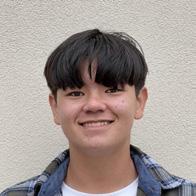
does volunteering bring positive change and impact to the community, through activities such as helping out with food and gift drives or providing tutoring ser vices, but Ben notes that he also benefits when he volunteers.
“[Volunteering is] a great experi ence. I get to observe how much I’m helping by working as a volunteer, which
really makes me happy. Really simple ac tions can lead up to bigger actions,” Ben said.
Read about what some other Harker community members are grateful for in the weeks of the season of thanks — and quickly-nearing season of giving — be low.
Visit harkeraquila.com for full article.
“In ninth grade, I was a new student. [I’m grateful] that my buddy and another girl started talking to me and took me under their wing”
“[Volunteering is] a great experience. I get to observe how much I’m helping by as a volunteer, which really makes me happy”
“I’m really grateful for my family. They’re always supportive of me, regardless of what endeavor I tackle”
LUKE WU
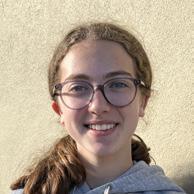
(9) STUDENT
SARA GLUSMAN (10) STUDENT


 BEN CHA
STUDENT
BEN CHA
STUDENT
(11)
IVORP
BYMICHE LLE JIN
MICHELLE JIN (12) STUDENT

WINGED POST 11 DOUBLETRUCK VOLUME 24 • ISSUE 3 NOVEMBER 14, 2022 DESIGN BY SABRINA ZHU
D E D
ILLUSTRATION BY SABRINA ZHU AS B R NA ZHU ED S I R EE LUO ED S R EE LUO
HALLOWEEN
THANKSGIVING
Pump-king of holidays Tur-key to my heart
Cotton-fiber cobwebs extend from window to window, speckled with minia ture plastic spiders. A larger, fuzzier spider looms above passing students, hanging off the Harker library entrance and contribut ing to the spooky sensations slowly build ing within the campus in anticipation for the best holiday of the year: Halloween.
Though many holidays such as Christmas or Thanksgiving boast more extravagant decorations or traditions, Halloween reigns superior due to its unri valed element of fun and its celebration of all things ghastly and grim, thus separat ing itself from every other holiday.
One staple tradition of Halloween is dressing up in costumes — from eerie monsters like witches and vampires to be loved characters or even household items. The amount of variety and creativity available in buying or creating costumes makes dressing up a major highlight of the holiday and offers a sense of escapism in disguising one’s identity and pretend ing to be someone or something else for a day.
Additionally, the decorations and traditions surrounding Halloween make for frightening fun, a feeling very distinct from the atmospheres of other hackneyed holidays. Watching horror movies, telling ghost stories and visiting haunted houses all contribute to the uniqueness of Hal loween. Whereas a holiday like Thanks giving demands a certain air of serious ness, Halloween is a holiday meant solely for enjoyment and entertainment.
And by far, the best part of Hallow een is the candy. Though trick-or-treating may be limited to younger children, the variety of candy on sale during the Hal loween season far surpasses the variety at any other times of year. Despite the fact that my memories of trick-or-treating as a lower schooler are fading year by year, I can always look to the sentimental taste of Nerds or Twix to remind myself of the ex perience — the giddy rush of excitement
I got when dumping out my bag of treats, the smiling jack-o-lantern design of my fraying felt tote bag, which was matching my glee.
I remember carefully arranging each pack of candy in rainbow order and finally gazing upon the magical, colorful array of sugar with eager eyes. That indescribable
The night of Thanksgiving, an array of various dishes will fill my entire table. Each person will be diving into as many plates as they can reach from my grand mother’s salad to the chicken adobo my mother spent hours making. Our Thanks giving dinner is a fusion of two unique cul tures with vastly different cuisines, yet co hesively delicious. With my chopsticks on one side and my fork on the other, I jump right in.
Being biracial, I’m typically either enjoying my mother’s homemade hot pot or ordering an animal style cheeseburger from In-n-Out. Either way, both cultures are rarely represented on the same table. Thanksgiving’s versatility creates a place for both pieces of my cultural identity to


easily emulate. Over the years, Thanksgiv ing has grown into a holiday celebrating appreciation and gratitude, losing its op pressive origins. The act of bonding over a plate of food, while simple, creates a mo ment to relate to one another as a family. For me, Thanksgiving is the best holiday — not only for its lasting memories but also for the moments of gratitude.
As the baby at the table, sometimes it can be intimidating to start conversations with my older family members. However, after a bit of time the tension eases away and conversation becomes more natural. Last year in particular, having not even fin ished freshman year, I was inexperienced in the ways of high school. My cousins, be ing seasoned veterans, took the opportu nity to give me some advice. From choos ing the best classes, to properly managing my time, our Thanksgiving feast became an opportunity for them to share their ex pertise, and allowed us to bond over our school experiences.
feeling of unconstrained joy has stuck with me, past all the platitudes of past Christmases and Thanksgivings. Although Thanksgiving does help families express gratitude, Halloween allows time for us to let loose, build those special trick-ortreating moments and escape from reality for even one night.
But Halloween has delightful, yet frightful, treats other than candy. Caramel “poisoned” apples, mummified hot dogs, tangerines made to look like pumpkins or plastic gloves filled with kettle corn — the possibilities of what can be changed into spooky, Halloween-inspired food are endless, and making these snacks with a creepy twist only makes them objectively taste better.
The candy, the spookiness and the pure fun are timeless aspects of Hallow een; they have cemented themselves as integral parts of many of our childhoods. Halloween appeals to all ages; it fills a pumpkin-sized hole in our hearts that Thanksgiving just doesn’t have the nostal gia or lightheartedness to match.
blend together, creating a traditional feast that welcomes both sides of my family’s customs.
From being surrounded by the famil iar faces of friends and family filling their stomachs with flavorful food, to compet ing for the last green bean on the plate, Thanksgiving creates an experience like no other. While other holidays, like Hal loween, are more spirited in their cele bration, Thanksgiving promotes a sense of connection that other holidays cannot
However, catching up with family is not the only notable trait of Thanksgiv ing. The mouth-watering platters of foods lined across the table create a major part of the Thanksgiving experience. The feel ing of connecting with my relatives under the smell of perfectly seasoned chicken adobo and stuffed turkey creates a bliss ful satisfaction that cannot be recreated anywhere else. The appetizing aroma of the entrées are a product of my mother’s tireless work when preparing the food. Hours before anyone arrives, my mother carefully dices the carrots, boils the eggs, meticulously measures the brown and white rice and chooses the perfect spices to match the pork. Because I know that be hind each ingredient was a series of deci sions on what’s the best seasoning to use, or how long to air fry the drumsticks, the day becomes even more special.
While Halloween has the reputation of being one of the most festive holidays, Thanksgiving is unmatched in its ability to bring people together through the prin ciples of gratitude and connection it rep resents.

DESIGN BY MARGARET CARTEE
ILLUSTRATION BY CLAIRE SU
margaret cartee
angelina burrows
Halloween reigns superior due to its unrivaled element of fun and its celebration of all things ghastly and grim, thus separating itself from every other holiday
12 WINGED POST OPINION VOLUME 24 • ISSUE 3 NOVEMBER 14, 2022
While other holidays are more spirited in their celebration, Thanksgiving promotes a sense of connection that other holidays can never hope to emulate
Editorial: Insensitive jokes harm environment
Assistant
Editors Selina
Content warning: This article mentions suicide.

For free and confidential support, call the Suicide and Crisis Lifeline at 988.
Discussions of answers and concerns circulate the room as anticipation rises for the teacher to pass back tests. But out of the myriad thoughts and remarks, one in partic ular passes by constantly without consideration.
“If I don’t get an A I’m gonna —”
We’ve all heard this comment before. Maybe you’ve even been the one to say it. These jokes dismiss suicidal thoughts as unimport ant, making it difficult to distinguish whether the person is trying to be fun ny or actually needs mental help. With suicide in the top three leading causes of death amongst teenagers, it’s alarm ing that we are so used to hearing these words that we don’t notice them any more. These jokes trivialize suicidal thoughts and imply that this problem is commonplace, normal and even insignificant.
gardless of people’s true intentions, jokes about suicide or other mental health issues treat these topics as punchlines for a quick laugh rather than serious problems that require discussion and potentially professional help.
Additionally, people on the receiving end of the humor often respond in ways that are unintentionally uncaring. Based on the same poll, out of respondees, 32.4% said they would laugh in response to a suicidal joke while another 33.5% said they would ignore it or change the topic of dis cussion.
However, when asked about what the proper approach to suicidal jokes should be, 54.9% chose the option “address the joke or express concern,” with only 20.9% actually doing this in a real situation. When presented with such situations, seek to understand first and then lend an ear to the person making the joke in order to foster a safe and empathetic environment for those around us.
Aquila Editors-in-Chief
Isha Moorjani Sally Zhu Humans of Harker Editor-in-Chief Tiffany Chang
According to a 2020 University of Tennessee study, people who make suicidal jokes are often those who are suffering from suicidal thoughts themselves. So, for peo ple who use these comments as an outlet, there are con crete ways to address these feelings in a healthier manner, including, for example, suicide hotlines to talk to health workers or genuine conversations with friends or trusted adults.
Considering that half of all lifelong mental health illnesses start by the age of 14, the age when many students start high school, our community should strive to maintain respect and demonstrate care when dis cussing these issues, especially in the years significant to our development.
We need to hold these discussions with our friends. Being mindful of others’ feelings means holding friends accountable for these jokes — as well as ourselves — with kindness and understanding since they could be struggling with suicidal thoughts.
Angelina Hu Yifan Li Chayce Milheim Lakshmi Mulgund Claire Su
Visit The Winged Post online at www.harkeraquila.com Follow us on Instagram @harkeraquila
The Winged Post is published every four to six weeks except during vacations by the Journalism: News and Advanced Journalism: News courses at Harker’s upper school, 500 Saratoga Ave., San Jose, California 95129.

The Winged Post staff will publish features, editorials, news, sports and STEM articles in an unbiased and professional manner and serve as a public forum for the students of The Harker School. Editorials represent the official opinions of The Winged Post. Opinions and letters represent the personal viewpoints of the writers and do not necessarily reflect the opinions of The Winged Post. All content decisions are made by student editors, and the content of The Winged Post in no way reflects the official policy of The Harker School. The opinions expressed in this publication reflect those of the student writers and not the Harker board, administration, faculty or adviser.
Letters to the Editor may be submitted to Manzanita 70 or emailed to harkeraq@gmail.com and must be signed, legible and concise. The staff reserves the right to edit letters to conform to Post style. Baseless accusations, insults, libelous statements, obscenities and letters that call for a disruption of the school day will not be considered for publication. Letters sent to The Winged Post will be published at the discretion of the editorial staff.
The Winged Post is the official student newspaper of Harker’s upper school and is distributed free of cost to students. Students hold the copyright to work published in Harker journalism publications.
NSPA Pacemaker Winner: 2019-2020, 2017-2018

NSPA Pacemaker Finalist: 2020-2021, 2018-2019, 2016-2017

CSPA Gold Crowns: 2019, 2018, 2016
CSPA Silver Crowns: 2022, 2021, 2017
Students telling such jokes during school meetings or during class only magnifies the issue. 47.3% of 182 Harker students and faculty, roughly one-fourth of our communi ty, who responded to a multiple-choice survey say that they or their friends make jokes about being suicidal “often.” Re
These steps are small actions to take but can go a long way in making people in our community feel less uncom fortable and more willing to come forward about struggles with mental health.
Visit harkeraquila.com for full article.
sarah
Hello! This is our third issue of the Winged Post, and we’re thrilled to share what we’ve been working on for the past six weeks!

In celebration of kindness week, this issue features a more introspective look at what our community does. From being more sensitive about the jokes we make to performing random acts of kindness, we hope you’ll come away from this issue excited to support our school community.
But we’re still mindful of the political conflicts the world faces today, and we’ve
made sure to discuss the nuances of those issues as well. We cover the results of the recent midterm elections and have cre ated space for social justice advocates to have their voices heard.
We can’t believe this is already the last issue of the calendar year, and hope to have made something that you can carry with you into January, through lush illustrations, bright photos, and stories featuring your friends and communi ty members. We hope you all have long, restful breaks full of pondering, spending time with those you love, and immersing yourselves in the events and issues taking place both on and off campus.
ILLUSTRATION BY MARGARET CARTEE
DESIGN BY MARGARET CARTEE
editorial board
EDITORIAL: THE OFFICIAL OPINION OF THE WINGED POST
News Editors
Emma Gao Ella Yee
A&E/Lifestyle Editors
Ariana Goetting Alena Suleiman
Editors-in-Chief
Sarah Mohammed Sabrina Zhu
Photo Editor Jessica Tang
Humans of Harker Managing Editors
Managing Editor Arjun Barrett
STEM Editors Edward Huang Kinnera Mulam
Opinions Editor Margaret Cartee
© 2022 Harker Journalism Publications
Adviser Whitney Huang, CJE
Sports Editor Katelyn Zhao
Features Editors Desiree Luo Ananya Sriram
Copy Editor Anika Maji
2 OPINION 9: Mirabelle Feng is the illustrator for the Forbidden History article STEM 15: Recommended misspelled as “Reccomended” in climate infographic • Cut-off source for climate infographic is the Red Cross SPORTS 17: Coach Theresa “Smitty” Smith’s quote repeats in the Gender Inequalities article
Angelina Burrows Gemma Chan Shiv Deokar Mirabelle Feng Jasleen Hansra 18: • Talk Around Campus student is Pavith Khara (9), not Pavitra Kasthuri (9) Warriors did not win the 2016 championship as shown in the Warriors
Reporters
Corrections TO ISSUE
SPORTS
infographic
Xu Medha Yarlagadda
CORRECTIONS POLICY: Our staff strives to represent our community fairly and to conduct accurate, truthful storytelling. However, if you do find any errors in an issue of the Winged Post, please let us know by emailing harkeraquila@gmail. com. We will list all errors of an issue, along with the page number of that error, in the next issue’s corrections box, which can be found in the Opinion section. mohammed, sabrina zhu & arjun barrett
Video/Podcast SABRINA ZHU
News Editors
Features Editors
A&E/Lifestyle Editors
Editors Young Min Alison Yang
These jokes trivialize suicidal thoughts and imply that this problem is commonplace, normal and even insignificant
Assistant
Assistant
Assistant Opinions
Isabella
Jessica Wang Assistant STEM Editors Victor Gong Andrew Liang Assistant Sports Editors Emma Milner Gabe Sachse Hima Thota Kevin Zhang Assistant Multimedia Editors Anwen Hao Aishani Singh Assistant Photo Editor Brandon Zau Assistant Copy Editors Saahil Herrero Claire Zhao
Shareen
Chahal Felix Chen Vika Gautham Katerina Matta
Lo
WINGED POST 13 OPINION VOLUME 24 • ISSUE 3 NOVEMBER 14, 2022
Michelle
Xu Katie Wang
Humans of Harker Profilers Jonathan Xue
Aryana Bharali Sidak Sanghari
Wei Olivia
Illuminating our marginalized scientists

Research fellow Dr. Jess Wade writes over 1750 Wikipedia bios for female scientists
edward huang & kinnera mulam
PROVIDED BY DR. JESS WADE
In 2018, British physicist and research fellow Dr. Jess Wade sat down and started to draft a Wikipedia article about American climate scientist Kim Cobb. No ticing Cobb’s outstand ing achievements which never received any recognition, Dr. Wade made it her mission to bring her and others’ achieve ments to light, publishing her first biography of over 1,750 articles featuring over looked female scientists and scientists of color.
Dr. Wade currently works at Blackett Laboratory in Im
perial College London, creating carbon based semiconductors for electrical de vices using quantum technology. During her time at university, Dr. Wade recalls witnessing the sheer diversity in the peo ple she worked with that caused her to fall in love with STEM and move into the ad ditional roles of a lecturer and professor.
“I never planned to have a career in academic science, but now I can’t imagine doing anything else,” Dr. Wade said.
Dr. Wade started writing Wikipedia articles for underrepresented female sci entists in 2018, gradually balancing out the male-dominated content on one of the largest websites in the world. Noticing the vast contributions of female scientists that often escaped public recognition, Dr. Wade strives to document their work and unearth their achievements.


“When I started editing biographies on Wikipedia, only 17% of them were about women,” Dr. Wade said. “According
to Wikipedia, only 17% of the notable peo ple on planet Earth were women, which really bummed me out. When you look closer at that, it’s pretty much all white women. There were very few female engi neers or engineers of color at all.”
Despite working at Blackett Labora tory for the majority of her day, Dr. Wade makes sure to publish a new Wikipedia article every day after returning home, no matter how exhausted she is. She writes about both past scientists and current ones, determined to both learn about fe male achievements in the field and shed light on their discoveries.
“I always have my scheduled Wikipe dia writing time because I find it so sooth ing and calming to have this time where I know what I’m going to do,” Dr. Wade said. “I really love being able to keep a better re cord of who scientists are and what they’re doing today.”
Visit harkeraquila.com for full article.
MITRA
Privacy
“I certify that I have read, understood, and agree to the terms and conditions.”
Containing pages of legal jargon and abstruse wording, these certifications seem to serve no use for the ordinary user. However, disturbing phrases lurk inside these agreements, forcing us to complete ly forfeit our data. With the quandary of wanting to use technical services while also maintaining privacy, the widespread technological revolutions of today have become increasingly nuanced, and some times, even dangerous.
Most of the content we consume is digital. But the connectivity we reap from this online ecosystem comes with a steep price: our data. For upper school computer science teacher Anu Datar, the greatest problem with current tech policy lies in the ambiguity of how our data can





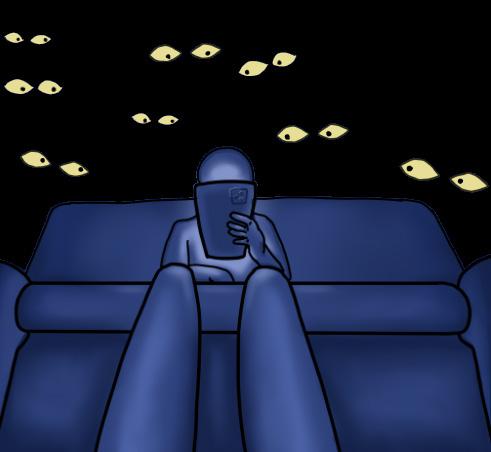


be used. With no clear-cut regulation on privacy, companies are mostly free to use consumers’ data as they desire.
“Many times users click on ‘Accept Terms and Conditions’ without really reading through them,” Datar said. “That’s the biggest thing, people not realizing how the information that they’re putting out there can be used.”
To many, casually scrolling through Instagram feeds or watching TikTok vid eos offers a comforting respite from the stress of everyday life. But even in these little moments, unseen algorithms run be hind the scenes, constantly collecting our data, essentially rendering a virtual model of each consumer.
In the quest for profit, corporations have not just cajoled us into sacrificing our privacy — they have also undermined free speech. Although most social media plat forms may seem to promote free speech,
they are not public forums; in fact, they are tools run by for-profit corporations. To maximize profit, they promote increasing ly extreme content for clicks and views at the cost of the integrity of online commu nication. Ethics and Philosophy Club Vice President Kabir Ramzan (11) emphasizes the issue of these systems.
“You’re surrounded with opinions that kind of reinforce your own beliefs,” Kabir said. “It grows the problem because now you’re just validating your own [opin ions], and that can lead to really danger ous outcomes.”
Moreover, content moderation pres ents many technical and social issues. The two main avenues for such moderation are algorithmic and manual. Given the recent advancements in AI algorithms that have accompanied the rise of social media, many large social media platforms have begun relying on these automated meth ods to moderate content automatically. Though efficient, such algorithms still frequently make mistakes, occasionally allowing harmful content to slip through and censoring all comments about con troversial topics altogether.
On the other hand, manual modera tion remains extremely time-consuming while also taking a psychological toll on the human moderators, who are inun dated with harmful content daily. With content algorithms pushing increasingly inflammatory messages, moderation is more necessary than ever.
We must reconsider the compromise we’ve so easily made with corporations, sacrificing our privacy for convenience and too easily consuming conversations orchestrated in companies’ interests.
Visit harkeraquila.com for full article.
STEM 14 WINGED POST VOLUME 24 • ISSUE 3 NOVEMBER 14, 2022
SPYING ON OUR HABITS In today’s world, the vast majority of social media apps con tain ways to monitor your every activity, keeping you on your screen to make profit.
jonathan xue
ILLUSTRATION
BY SHAREEN CHAHAL
DESIGN BY EDWARD HUANG
is dead. We are the ones who killed it Big tech’s monopoly on data threatens our democracy
WOMAN IN STEM Physicist and research fellow Dr. Jess Wade poses with a bottle of non-Newtonian fluid.
GLADYS WEST
African-American mathematician who made major contributions to modeling the shape of the Earth using satellite geodesy
SUMITA
Indian-American chemist who designed nanomaterials that imitated human teeth to be used in dental fillers
ELIZABETH SUDMEIER
White founding member of the Central Intelligence Agency who managed overseas information, campaigned for equal rights and pay for women
YVETTE CALDERON
Puerto Rican physician and professor who led New York in combating both HIV and the COVID-19 pandemic
ILLUSTRATIONS
BY SHAREEN CHAHAL AND KINNERA MULAM
ILLUSTRATIONS BY MIRABELLE FENG & YIFAN LI
36% TikTok user data shared with third parties, including location and browsing history 79% Instagram user data shared with third parties, the most out of any social media app 50% Twitter user data collected for profit, including user purchases and contact information SOURCE: PCLOUD.COM
Blooming from the STEM: Activist in Tech


and human rights
sid sanghari & michelle wei
Draw a Venn diagram with policy, human rights and technology. What do these three fields have in common? Jes sica Dickinson Goodman (‘07) stands at the center of this Venn diagram.
Dickinson Goodman graduated from Harker Upper School in 2007 after spend ing four years participating in the Junior Classical League (JCL), the place where she fostered her love for learning languag es. Furthermore, she also sang in Cantile na, directed by upper school vocal music teacher Susan Nace who also taught Dick inson Goodman in Study of Music.
Discovering her passion for human rights at Harker, Dickinson Goodman went on to pursue a unique career path that blended policy, human rights and technology, whether she was working as a scheduler for Vice President Kamala Har ris or running a website and campaigns at Harvard Law School for survivors of hu man trafficking, or even in her current job as President of the Board of the San Fran cisco Bay Area Internet Society. Dickin son Goodman reflects on how working in all three fields allowed her to continually challenge herself while working to em power others.
Using her technical skills in STEM, Dickinson Goodman also volunteers for TechWomen, a U.S. organization that sup ports women interested in STEM around the world. Throughout her time working with the women, Dickinson Goodman re calls her trip during a Gaza–Israel conflict in 2016, where she faced a difficult deci sion in deciding to travel to work there.
“She’s about community,” Nace said. “You think of people who are political ly active as having a particular agenda. It’s not that Jessica doesn’t have certain things she does, but she just has a love of the world and [a want for] things to be bet ter, and whatever she does, it’s about mak ing the world better.”
Visit harkeraquila.com for full article.
Q&A WITH JESSICA DICKINSON GOODMAN
Q: What was something that sparked your interest in activism?
A: “After 9/11, it was important to me to make a public stance in support of Muslim women. After that, people in my life knew this was something I cared about.”
Q: Why did you choose to get involved in the Middle East?
A: “I really liked getting a better understanding of what the U.S.’s role in the region has been and what the relationship with different extremist movements has been.”
Q: How does your identity impact your work?
A: “As an activist and feminist, I enter every policy, human rights and technology discussion with the mindset of not what the law says but what I think is right.”
STEM Spotlight: Medical Club Evening of Medicine
Club event invites students to explore medical professions through activities
to come up with more intelligent and less aggressive treatments going forward.”
Medical Club member Melody Yin (10) expresses her admiration for Dr. Tass and his valuable research. Having done medical research herself, including her own studies about concussions, she finds his work to be inspiring and hopes to one day experience the same level of success.
“I’ve always been really interested in STEM and its applications towards other people,” Melody said. “It was especially inspiring to see someone, especially from a place so close to home, working so hard and having some really interesting results with his patients, and I’m hopeful to see how his research might affect people suf fering from Parkinson’s in the future.”
STEM UPDATE
young min & claire zhao
LOWERING EMISSIONS
Various nations pledge to reduce fuel emissions

Almost 200 nations agreed on Oct. 7 to lower carbon emissions from airplanes by 2050 in meetings overseen by the U.N.’s International Civil Aviation Organization (ICAO). The initiatives entail either investing in more fuelefficient planes or reducing air travel, and emissions need to peak and start decreasing by 2025. Although some nations are more committed than others, the collective acknowledgement of the issue remains a step forward in combating climate change.
UGANDA EBOLA OUTBREAK


A new strain of ebola sweeps through Uganda
With 44 confirmed cases and 10 deaths, the Ebola outbreak in Uganda is threatening other East African countries, especially due to the outbreak strain’s lack of treatment. Ervebo, an injectable vaccine highly successful in maintaining the Zaire strain, does not work on the current Sudan strain. No official medical treatment currently exists. In response, the U.S. is currently screening travelers coming from Uganda for symptoms of Ebola but has yet to find any people displaying symptoms.
RAT BRAIN CELL TRANSPLANTS
Around 50 students attended the Eve ning of Medicine, hosted by Medical Club in Nichols on Friday from 6:30 to 9 p.m.
The event included two guest speak ers and three interactive workshops, pro viding students with the opportunity to learn more about various aspects of medi cal fields such as neurosurgery, anatomy, laparoscopy, and bariatric surgery. Medi cal Club Co-President Jonathan Mo (12) reflects on the club’s process with recruit ing mentors willing to speak at the event.
“Medical club has a mentorship pro gram, so our first step in running the Eve ning of Medicine was to contact all the mentors, just to see who was interested,”
Jonathan said. “Even though we had a few last-minute changes to the lineup, I think we were still able to host what was hope fully a good event.”
First, students gathered in the Nich ols Auditorium for Stanford neurosurgery professor Dr. Peter Tass’s presentation on treating Parkinson’s disease with a vibrat ing glove. Currently in his fourth year as a Medical Club mentor, he stressed the im portance of intersectionality within vari ous STEM fields.
“It’s important to learn as much math and physics as possible for medicine,” Dr. Tass said. “Physics is not only a tool to help develop tools like the X-ray but also a way to approach the medical field as more of a systems theory. [In doing so,] we’ll be able
After the speaker event, attendees separated into groups to participate in three rotating workshops. The medical il lustration workshop, hosted by Medical Club member Anika Mantripragada (11), focused on art and medicine and focused on drawing an anatomically correct skull.

Upper school biology teacher Dr. Matthew Harley hosted the heart dissec tion workshop in his own room. After ex plaining the parts and functions of a hu man heart, Dr. Harley allowed students to probe and observe freshly dissected pig hearts purchased from Lion Market.

Stanford Medicine Children’s Health general surgeon Dr. Janey Pratt, who spe cializes in robotic hernia repair, hosted the laparoscopic surgery workshop in upper school computer science teacher Susan King’s room. Students tried their hand at laparoscopic surgery by playing with dif ferent surgical tools and testing their skills with a surgical simulation.
Visit harkeraquila.com for full article.
Researchers put brain cells into baby rats to study disorders Stanford University scientists transplanted human brain cells into baby rats in order to study developmental disorders like autism and schizophrenia. According to Dr. Sergiu Pasca, who authored the study, this is the first time organoids have been put into baby rat brains, creating the most realistic and complex model yet of how a human brain functions. Neurosurgeon Dr. Isaac Chen, who was not part of the study, stated that these new findings potentially lead the way for future medical breakthroughs in repairing brain damage.
ACTIVISTS STEAL PIGLETS
Jury acquits two animal activists who stole two piglets
After a group of animal activists posted a video of themselves stealing two pigs from Circle Four Farms in 2017, the Federal Bureau of Investigation (FBI) launched an investigation into various farms located in Colorado and Utah in search of evidence weeks after the initial posting of the video. The activists explained how mass-producing meat companies like Smithfield throw out and starve sick animals, prompting them to “save” two piglets. A jury acquitted the two activists on Oct. 8.
Visit harkeraquila.com for full article.
STEM WINGED POST 15 VOLUME 24 • ISSUE 3 NOVEMBER 14, 2022
PROVIDED BY JESSICA DICKINSON GOODMAN
EMPOWERING WOMEN Jessica Dickinson Goodman (‘07), who supports and educates underprivileged women in STEM fields, holds up cards of notable women in computing. She has traveled to numerous countries in Africa and the Middle East to teach technology.
IDENTIFYING STRUCTURE Medical Club Transition Team Member Edis Mesic (11) and Co-President Jessica Zhou (12) examine a pig’s heart during Friday’s Evening of Medicine.
Over 50 students attended the event, which included guest speeches and workshops. jessica wang, alison yang & claire zhao
CLAIRE ZHAO
DESIGN BY VICTOR GONG AND ANDREW LIANG ILLUSTRATIONS BY KINNERA MULAM
Jessica Dickinson Goodman (‘07) blends STEM, politics
How climate change infects our world
Global warming triggers the spread of viral diseases
 shareen chahal & kinnera mulam
shareen chahal & kinnera mulam

We’re now living three years after the start of the COVID-19 pandemic, an event that took the lives of 6.6 million and changed our meaning of “normal” per manently. COVID-19 isn’t the first nor the last of deadly viral outbreaks with the 1968 Influenza A pandemic and the 1981 HIV epidemic producing similar effects. Cases of new emerging viruses are be coming more common now with a 22-28% chance of the next pandemic of the same severity as COVID-19 taking place within a decade. Despite the perhaps unexpect ed connection, the issue boils down to cli mate change.
the specific symptoms of the situation,” Research Club Officer Arnav Swaroop (11) said. “To try, you could leave some amount of land like forest land untouched and constrict human urbanization.”
From rising sea levels to wildfires, habitat destruction wipes out species, but also leaves animals with no place left to go but towards the poles. 50% of all wildlife are migrating in search of cooler climates and new habitats, with some species aver aging travel times of 40 miles a decade.

As animals trek across the globe, they come into contact with species that they wouldn’t have run into under normal cir cumstances. These cross-animal interac tions permit new viruses, called zoonotic diseases according to upper school biol ogy teacher Dr. Matthew Harley, to jump from host to host. Often, these viruses have not been encountered by the animal, fostering unprecedented rates of disease transmission. 75% of recent viral diseases, including COVID-19, originated from an imals. These incidents both increase the frequency of pandemics and the severity due to expedited transmission.
ing temperatures don’t cause viruses to mutate, warmer weather directly links to spread of disease since people are outside more often, allowing for higher infection rates, increasing the risk of mutation.


















 DR. MATTHEW HARLEY UPPER SCHOOL BIOLOGY TEACHER OFFICE OF COMMUNICATION
DR. MATTHEW HARLEY UPPER SCHOOL BIOLOGY TEACHER OFFICE OF COMMUNICATION
Although climate change is a wide spread movement, debates over whether people are doing enough continue.
The main source of spread of dis ease fueled by climate change is the de struction of ecosystems. Through burn ing, melting, shrinking and more, global warming wears away at animal habitats. The effects are increasing exponentially at unprecedented rates as seen in Green land, where a melting ice sheet will result in a 10.6 inch increase in sea levels, twice the amount initially predicted. Just a foot increase in sea levels swallows up 100 feet of coastline, displacing thousands of ani mals.
“Since the real issue is climate change, anything to reduce the change in temperature, which creates these issues [is] probably a good step to actually treat
In addition to animals spreading vi ruses, permafrost is melting at rapid rates, uncovering new diseases. Although per mafrost primarily inhabits Arctic regions, viruses can piggyback on animals as they migrate and escape into water supplies.
DEFINITION
“These layers of permanently frozen soil thawing have viruses in there [that] the earth hasn’t seen in potentially mil lions of years,” Dr. Harley said. “Certainly humans haven’t seen them and had any immune system response to them.”
With increased disease transmission comes more mutations. Although ris
“I think [climate change] is solvable if we take it seriously,” Public Health Club Officer Young Min (10) said. “The govern ment has to be willing to change in order for climate change, [and], as a global pop ulation, we [need to] take the initiative to collectively lower our CO2 emissions and actually care for our planet.”
With 42% of adults displaying mis trust in vaccines in the COVID-19 pan demic, belief in science has waned. Dr. Harley emphasizes the importance of ed ucation in a time when global warming’s effects are increasing unpredictably.
“A lot of people have lost their faith in science and don’t understand how sci ence is done, how much we know from the scientific studies and how believable they really are,” Dr. Harley said. “So educate yourself, help educate others both more generally about science but then about potentially these individual viruses and their diseases. [Most importantly] heed the cautions that scientists and doctors are trying to spread.”
Visit harkeraquila.com for full article.
DESIGN BY KINNERA MULAM
a global population, we [need
“As
to] take the initiative to collectively lower our CO2 emissions and actually care for our planet” YOUNG MIN (10) PUBLIC HEALTH CLUB OFFICER “Educate yourself, help educate others [and] heed the cautions that scientists and doctors are trying to spread”
23% of natural habitats to disappear by
45% rise in global warming’s effects on planet 75% of recent viral diseases originated from animals 50% of species migrating for cooler environments Global Reset highlights topics related to climate change and how they pertain
every
the paper HABITAT DESTRUCTION Global warming depletes resources like water and food in addition to melting, burning and wearing away animal habitats 0.5 1.0 1.5 ANIMAL MIGRATIONS Ecosystems’ deterioration and rising temperatures cause animals to migrate towards higher latitudes in search of cooler climates DISEASE TRANSMISSION Animal migrations increase cross-animal interactions, resulting in exposing human populations to new infectious diseases 1975 | 1980 0.0 MAJOR EMERGING VIRUSES AND RISING GLOBAL TEMPERATURES OF THE PAST FOUR DECADES SURFACE TEMPERATURE DEVIATION (°C) 1990 | 1995 1995 | 2000 2000 | 2005 2005 | 2010 2010 | 2015 2015 | 2020 1985 | 1990 1980 | 1985 1981 2002 2009 2012 2013 2019 WHY DOES THIS MATTER? Increasing global surface temperatures contribute to the spread of disease in addition to producing more frequent and severe pandemics INFLUENZA A H1N1 MERS-CoV EBOLA VIRUS SARS-CoV-2 ILLUSTRATIONS BY KINNERA MULAM HIV SARS-CoV 2.0 DATA FROM NASA, NATIONAL LIBRARY OF MEDICINE FAST FACTS DATA FROM NATIONAL GEOGRAPHIC, EPA, CLIMATE.GOV OFFICE OF COMMUNICATION 16 WINGED POST STEM VOLUME 24 • ISSUE 3 NOVEMBER 14, 2022
FAST FACTS
end of century
to the Harker community in
issue of
permafrost: permanently frozen ground primarily found in Arctic regions
Fencer advances through life one lunge at a time Ishani

Sood
(11) faces off against opponents with fierce spirit
thota
Sweat drips off Ishani Sood (11)’s brow as she readies herself before a final bout. With just 30 seconds left on the clock, she needs 5 points to win, while her opponent only needs 1. Setting slim chances aside, she plants her feet, takes a deep breath, and prepares herself for the round ahead. Lunging toward her opponent, Ishani takes on the challenge.
Ishani recalls an intense experience in the Fortune Fencing Summer Regional Junior and Cadet Circuit Competition, where she took first in Junior Women’s Foil. Introduced to fencing at eight years old by her older brother, she worked over the years to become a nationally ranked
“What’s important is that you have to love what you’re putting time into. I truly love [fencing]. That’s why I’ve done it all these years and that’s what keeps me going. I love everything about fencing”
ISHANI SOOD (11) FENCING ATHLETE OFFICE OF

fencing champion, practicing four times a week at the California Fencing Academy. With local, national and international events, she participates in at least one competition each month.
Ishani’s greatest achievement in fencing so far is her win at the Summer Nationals in Division 1A this year. Following her placement into a directelimination draw after coming out at the top of her pool, she successfully won each round, ending with a gold medal as well as a high ranking.
“I feel like all the hard work that I had done over the past couple years was very rewarding,” Ishani said. “It just felt like everything had finally come into one place, and I finally achieved what
I wanted. It was just the most satisfying thing that’s ever happened to me.”
Ishani describes the mental setbacks she faced during the tournament and how confidence is one of the key aspects of overcoming doubt. She also notes how staying focused in the moment helps her assume control during competition.
“During that competition actually, the very first bout I had, I almost lost,” Ishani said. “It was 15-14 and I was losing so that was extremely terrifying. If I hadn’t won that one, I wouldn’t have gotten first – I would have been out. [In] that whole experience, I was like ‘Okay I can’t let that happen again.’”

Coach Ania Tibbets, who has coached Ishani since she first started the sport, recognizes her determined spirit and dedication. As Ishani’s coach throughout her journey to national championships as well as the Pan American Games, Tibbets notes Ishani’s constant desire for perfection in every detail of her fencing.
“She likes to do everything perfectly well, and [she works] very hard, sometimes too hard,” Tibbets said. “She’s a fighter [and] she’s been a fighter since she was young. The other coaches used to call her little tiger.”
Close friend Shareen Chahal (11), who met Ishani in kindergarten, recalls a time when Ishani struggled with doubts about her performance as a fencer. However, Ishani pushed through selfdoubt to win her competitions.
“We talked about how she was really stressed and worried about how she was going to do at an upcoming national competition,” Shareen said. “She won and was really proud of her performance. I’ve [never] seen her that happy for her own accomplishment, and I was so proud of how much effort she puts into getting those results.”
Although she has won many medals over the years, Ishani notes that the learning process has been more valuable, especially at times when she wasn’t able to gain the results she wanted.
“The things that shape you more are the times that when you learn more from your losses than your actual wins,” Ishani said. “[So] I find it in myself to win those last rounds even when I struggle.”
Ishani, traveling internationally to tournaments means that she represents Team USA alongside her supportive teammates. She competed twice in France this past year, and plans to travel to Germany, Hungary, Italy and Poland in the coming months.
Visit

Twirling under the stars: figure skating Grand Prix 2022 commences
The 2022 figure skating Grand Prix, a series of senior invitational internationals, begins with the first event Skate America in Massachusetts and finishes at the Grand Prix Finals in Italy.
Six competitions lead up to the 2022 Grand Prix Final, Skate America started on Oct. 21, followed by Skate Canada on Oct. 28 and the Grand Prix de France on Nov. 4.
The event replacing the Rostelecom Cup, the event that was previously held in Russia that will not be happening this year, is the MK John Wilson Trophy, hosted in England on Nov. 11. Next is the NHK Trophy in Sapporo, Japan, from Nov. 18-20, and lastly the Grand Prix of Espoo, in Finland, from Nov. 25-27.
The Grand Prix will bar Russia and Belarus from competition following the Russian attack on Ukraine. Since figure skating is statesponsored in Russia, sanctions were placed against the skaters in an attempt to hurt the country’s soft powers, the arts and
athletics. Figure skating is a combination of both.Russia will be holding its own competitions in the meantime, inviting international participants to compete.
However, the international attendees will most likely consist of only Belarusian and Chinese skaters.
The Russians previously held the smallest presence in the men’s discipline. Many other countries, such as the United States, Japan, Korea and Canada, hold a strong presence in the men’s discipline, which prevented complete Russian dominance. However, after the retirement of Yuzuru Hanyu, two-time Olympic gold medalist and worldwide fan favorite,, as well as that of Nathan Chen, reigning Olympic gold medalist, the field is still lackluster.
For Japan, Shoma Uno, previously second in scores only to Hanyu, poses as a strong candidate for achieving success in future competitions. Although he struggles with the mental aspect of the sport, his technical skills are exemplary. But he needs to maintain consistency when he competes in order to take the gold medal.
Japan’s now-second top male skater after Uno, Yuma Kagiyama, will miss the competition due to a foot injury.
The crowds now regard American Ilia

Malinin as the next technical powerhouse in the United States after being the first skater to land the quadruple axel in competition on September 15, in the U.S. International Figure Skating Classic.
Meanwhile, pair skating was greatly dominated by the Russians. Tamara Mosvkina, the coach known for fostering pairs talent, wrote the International Skating Union judging handbook for pair skating. However, none of her teams will be able to compete due to the ban.
Similarly, in ice dance, the competition is barren due to the absence of the Russians. Although both ice dance and pair skating involve two people skating in as much unison as possible, the key difference is that in ice dance, the skaters do not perform jumps. Instead, the focus is on completing complicated step sequences and spins.

The APEX repeater profiles the Harker athletes who compete at the highest level within their respective sports.
This installment features Ishani Sood’s wins as a national fencer.
after the 2022 Beijing Olympics, such as the Canadian team consisting of Gabriella Papadakis and Guillaume Cizeron and Spanish skaters Olivia Smart and Adrián Díaz.
The only prominent group remaining, the American team of Madison Chock and Evan Bates, are not only teammates but also fianceés, who went viral in 2020 for their snake charmer routine.
Competition will rely more heavily on consistency, as most of the ladies are able to jump triple jumps, such as the triple flip or loop.
Ongoing debate within the figure skating community revolves around whether the Russian’s presence in the sport had a positive or negative impact on it: on one side, their unreasonably and also unhealthily high technical level concerns many viewers, however, on the other side, they generate the drama and therefore interest in figure skating from the masses. The Grand Prix 2022 is shaping up to be the stage where the argument finally lays to rest.
Similar to the men, the Japanese ladies are easily the best skaters now.
Visit harkeraquila.com for full article.
Several ice dance teams retired
For
WINGED POST 17 SPORTS VOLUME 24 • ISSUE 3 NOVEMBER 14, 2022 DESIGN BY KATELYN ZHAO
harkeraquila.com for full article.
ILLUSTRATIONS BY JESSICA WANG
jessica wang
gemma chan, chayce milheim, emma milner & hima
COMMUNICATION
EMMA MILNER
EN GARDE Ishani Sood (11) lunges forward with foil in hand, ready to advance. As a nationally ranked fencer, she trained for eight years and recently joined Team USA Fencing.
Sister Act: Two sister pairs make memories together
admissions director and Sydney and Summer’s mother, notes how being teammates formed a closer bond between the two in their relationship outside of water polo.
“I think that water polo has been a nice uniting factor in high school, and it’s nice that the season was in the fall in ninth grade because it started that process of them really growing [closer] together,” Hargreaves said.

She also observes how they get along more smoothly at home as sisters and are able to discuss their common interests with each other in a more light-hearted and friendly way.
“We’re all pumped and looking to start our season locked in. We’re working as a collective towards winning league. Last season went by in a blink, and I don’t take any game for granted”
CIFFO
O F COMMUN ICATION
ASHLEY MO (9) GIRLS GOLF
One team. Two pairs of sisters. Together in the pool, they pass the ball around to each other as teammates. Later, they go home as sisters, bonding over the moments in practice and games.
Sydney Adler (12) and Summer Adler (10), along with Jasleen Hansra (12) and Jasmine Hansra (9), play together as two pairs of sisters on the varsity girls water polo team. Although they all played club water polo at San Jose Express prior to joining Harker’s water polo team, they never had the opportunity to play together on one team. However, Harker’s water polo team has provided them with a space where they can do just that and share their wins and memories together.
Playing water polo together shaped their relationship with each other, bringing them closer and onto the same level with each other. Summer, who has played with Sydney for the past two years, found the connection new and exciting.
“It’s pretty cool,” Summer said. “I feel like this is an experience that only two other people have on the team, which is to finish a game, get in the same car, go home, and maybe bring up something that happened in the game and talk about it because you both experienced it.”
Summer notes how club water polo
Game Talk with Gabe: 49ers rise
The San Francisco 49ers season has not started as planned. Just 8 games into the season, their record sits at 4-4, with setbacks occurring in just those few games. Third overall draft pick and starting quarterback for the team Trey Lance suffered a season-ending injury to his ankle in the team’s second game against the Seattle Seahawks.

Former starter Jimmy Garoppolo stepped in to replace Lance, a move that disheartened many fans who looked forward to watching Lance play after several disappointing playoff runs with Garoppolo. Despite a strong victory against the Seahawks after Garoppolo replaced Lance, the recent losses to the Denver Broncos and Atlanta Falcons, teams thought of as bottom-feeders in the league, shook fans’ faith even further. Everything was going downhill for the 49ers– until the biggest blockbuster trade in the league this year went down, with the 49ers acquiring superstar running back Christian McCaffrey from the Carolina Panthers who first gained attention as a Heisman Trophy contender for the local Stanford Cardinal in college.
Visit harkeraquila.com for full article
does not provide the same experience as high school water polo does, as she is now able to bring aspects of the water polo game home with her sister.
“I didn’t really realize how special it is to practice and play on the same team with her…and then go home with [her] since I’ve never done that before, since we’re not in the same age group for club [water polo],” Summer said. “If it weren’t for high school, I would never play on the same team as her.”
Sydney reflects on how as they spent more time together on the same team, they became closer and closer. Her shared experiences with her sister in water polo became treasurable memories.

“I think that it’s been a progression,” Sydney said. “Last year we were not as close as we are this year. We wouldn’t really want to spend time with each other, so being on a team didn’t really mean much, but now I can go to practice and hang out with my sister and it’s fun. And then going home and [talking] about stuff that happened at the game, stuff that happened at practice – it’s really fun.”

Jennifer Hargreaves, upper school
“I just see them interacting at home more as friends and not bickering as much,” Hargreaves said. “I just see camaraderie more and see like ‘Oh we have to be together because we’re sisters’ — like a choice to be together, laugh about things, talk about things and share interests.”

The other pair of sisters, Jasleen and Jasmine, found that their relationship helped them in the pool as Jasleen gives tips and pointers to Jasmine, making sure that her younger sister is prepared for the games.
“My position is mainly a defense position,” Jasleen said. “So there’s a lot of communication between the two of us when we’re on defense – like her being a goalie and me being a big defensive player. There’s a lot of communication involved, and I definitely think that being sisters helps.”
In Jasmine’s first year with the team, Jasleen served as a mentor figure for her. Even as Jasleen was sidelined with a concussion, the pair still supported each other.
“I think knowing each other [helped], because when I started the team I didn’t know any of the other players except for the freshmen,” Jasmine said.
Visit harkeraquila.com for full article.
UPCOMING SPORTS GAMES
Nov. 18 - Varsity Girls Soccer vs Design Tech at 3:30 p.m.
Nov. 19 - Junior Varsity Boys Basketball vs Aptos at 9:30 a.m.

Nov. 19 - Varsity Boys Basketball vs Aptos at 11:00 a.m.
Nov. 22 - Frosh Boys Basketball vs Stratford San Jose at 4 p.m.
Dec. 1 - Varsity Boys Soccer vs San Francisco International at 3 p.m.
Dec. 1 - Junior Varsity Boys Soccer vs San Francisco at 4:30 p.m.
Dec. 6 - Junior Varsity Girls Basketball vs Lincoln at 5 p.m.
Dec. 6 - Varsity Girls Basketball vs Lincoln at 6:30 p.m.
Amidst fall CCS tournaments, winter sports kicks off
the season with a score of 13-14, but fell against Carmel High School in a close four-set game. Boys water polo finished the season with an overall score of 18-8 but lost 11-17 against Bellarmine in the quarterfinals.
Girls water polo, after finishing the season with an overall score of 20-7, qualified for the CCS Division II Championships. They beat Carmel High School with a score of 11-4 in the quarterfinals on Nov. 5. The team plays against Santa Cruz High School on Nov. 9.
The winter season also officially began, and the sports include girls basketball and soccer, and boys basketball and soccer. Following successful seasons for both teams in 2021-22, they moved up a division, a challenge both teams are ready to take on.
“Both girls soccer and girls basketball moved up into a tougher division,” upper
Girls varsity golf finished the season undefeated in their league with an overall score of 14-0. They won their sixth consecutive West Bay Athletic League (WBAL) Championship title. With this win, they qualified for the CCS Championships, where they came in second place. This win enabled them to compete in the Northern California Championships, placing sixth on Nov. 7.
“I think a lot of why we won is because our team chemistry is really strong and there’s a lot of bonding,” Claire Chen (12) said. “CCS was really tough because it was like really heavy rain and really strong winds, but I’m really proud
of everybody pursuing through that and staying calm and not getting frustrated through conditions we don’t usually get.”
Girls tennis finished the season with a 9-1 score, with only one loss against Menlo. The team looks forward to the first round of CCS on Thursday. Alongside the girls’ team, senior Kara Kister, a cross country member, also awaits the upcoming CCS tournaments as the only member of her team that qualified for CCS. Overall, the girls cross country team came in eighth place, while the boys cross country team placed third, qualifying them for CCS.
The girls volleyball and boys water polo teams, although ending the season on a high note, fell short in their respective CCS quarterfinals. Girls volleyball ended
went
CLAIRE CHEN
VARSITY GIRLS GOLF PLAYER
school athletics director Dan Molin said. “It’s going to be a lot tougher as far as competition is concerned.”
Visit harkeraquila.com for full article
18 WINGED POST SPORTS VOLUME 24 • ISSUE 3 NOVEMBER 14, 2022 DESIGN BY KATELYN ZHAO
(12)
NIVEK Z H ANG ABHI NAMALA
BOYS BASKETBALL
gabe sachse
emma milner & hima thota
E
“It was a fun season, especially because we were undefeated.
After CCS, it was a relief that we got through it because it was one of our goals at the beginning of the season”
“We
undefeated in leagues, and we also won the league championships. It’s been a good time getting to know the girls and becoming close with each other too”
OFFICE
COMMUNICATION
(12)
OF
BRANDON ZAU
WATCHING THE BALL The boys soccer team play a drill of possession on Thursday. The soccer team held tryouts the week of Oct. 31, and the team started practices the week after.
isabella lo & emma milner
KATELYN ZHAO
TALK AROUND CAMPUS
EMMA MILNER
ILLUSTRATION BY HIMA THOTA
FREEZE FRAME

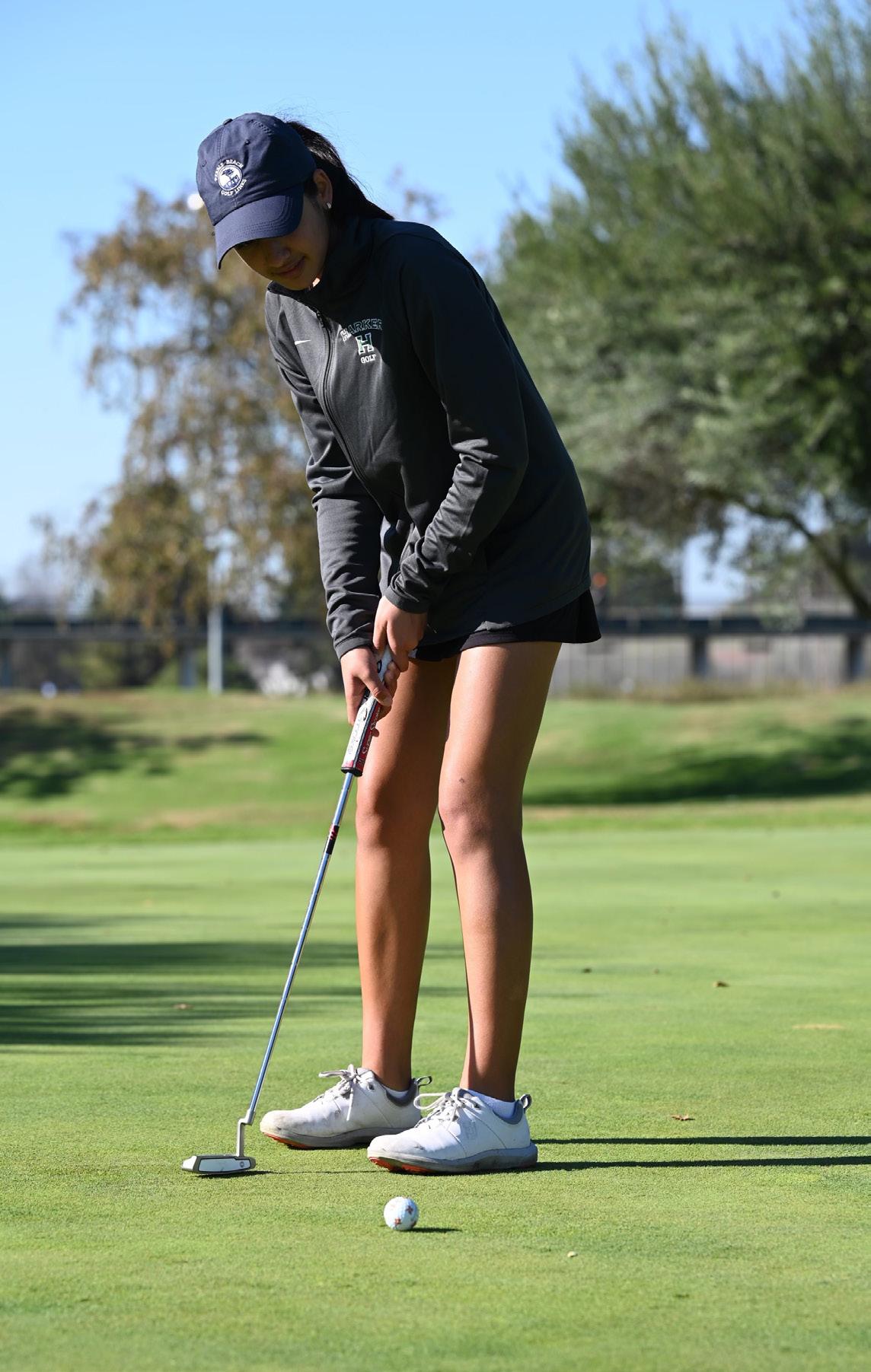
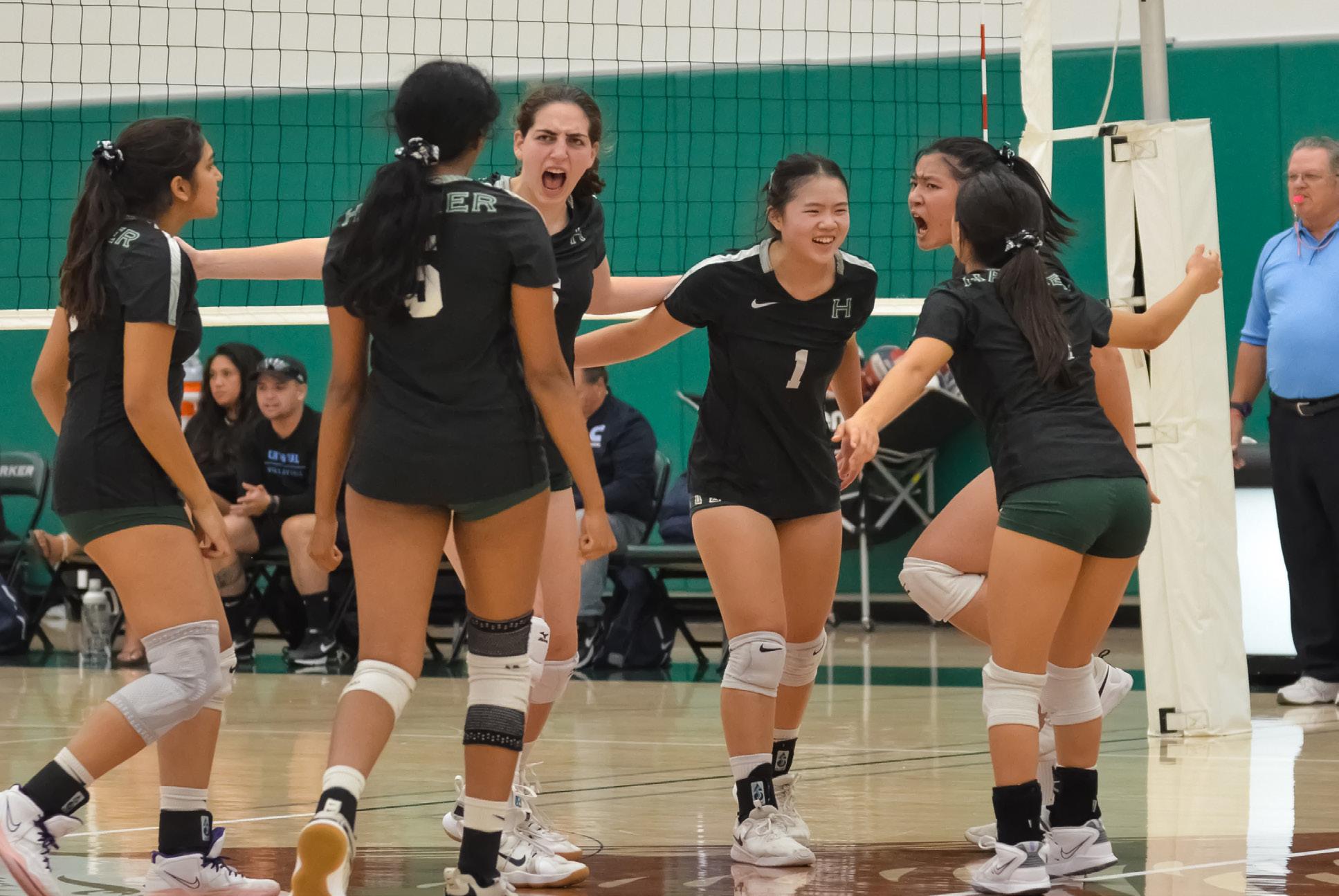






WINGED POST 19 SPORTS VOLUME 24 • ISSUE 3 NOVEMBER 14, 2022 DESIGN BY BRANDON ZAU AND KATELYN ZHAO
PHOTOS OF THE MONTH, CURATED BY OUR SPORTS TEAM
LOCKED AND LOADED Sydney Adler (12) aims for the goal during the girls waterpolo game against Palo Alto High School. The girls defeated Santa Cruz High School in their CCS semifinals matchup.
KATIE WANG
SHOOT FOR THE WIN Senior Thomas Wisdom shoots a ball during the boys waterpolo senior night game against Palo Alto High School. The team fell to Bellarmine in the CCS quarterfinals.
HANDS HIGH Cheerleaders Kashish Priyam (10), James Blenko (11) and Sarah Westgate (11) assemble into formation at halftime.
BRANDON ZAU
KEVIN ZHANG
DOUBLE THREAT Ada Praun-Petrovic (12) runs alongside Emma Gao (11). Cross country runners competed in CCS on Saturday.
SWING BACK Anushka Mehrotra (12) lunges to return a serve during a match on senior night. The girls varsity tennis team won 6-0.
WITH FOCUS Kimaya Mehta (9) putts the golf ball toward the hole. The girls varsity golf team placed second in CCS, and they advanced to the NorCal Championship, where they placed sixth.
KEVIN ZHANG
SENIOR CELEBRATIONS Senior football players Freddy Hoch, Rohan Gorti, Dylan Parikh and Chris Tonev lineup to take pictures with their families. The senior night ceremony was held before the team’s last home game on Oct. 28.
KEVIN ZHANG
JONATHAN XUE
TEAM RALLY Varsity girls volleyball players huddle together in celebration after scoring on a possession. The Eagles won the third and fourth sets of their senior night game against the Crystal Springs High School.
KEVIN ZHANG
SABRINA ZHU
JONATHAN XUE
AHEAD OF THE CROWD Boys cross country members compete in their last meet of the season at Crystal Springs High School.

20 WINGED POST BACK PAGE VOLUME 24 • ISSUE 3 NOVEMBER 14, 2022 ILLUSTRATION BY MIRABELLE FENG




















 shareen chahal
shareen chahal








 SONYA APSEY (11) UPPER SCHOOL STUDENT
SONYA APSEY (11) UPPER SCHOOL STUDENT





















 JESSICA WANG (10) STUDENT
JESSICA WANG (10) STUDENT




















































 shareen chahal & kinnera mulam
shareen chahal & kinnera mulam


















 DR. MATTHEW HARLEY UPPER SCHOOL BIOLOGY TEACHER OFFICE OF COMMUNICATION
DR. MATTHEW HARLEY UPPER SCHOOL BIOLOGY TEACHER OFFICE OF COMMUNICATION





















